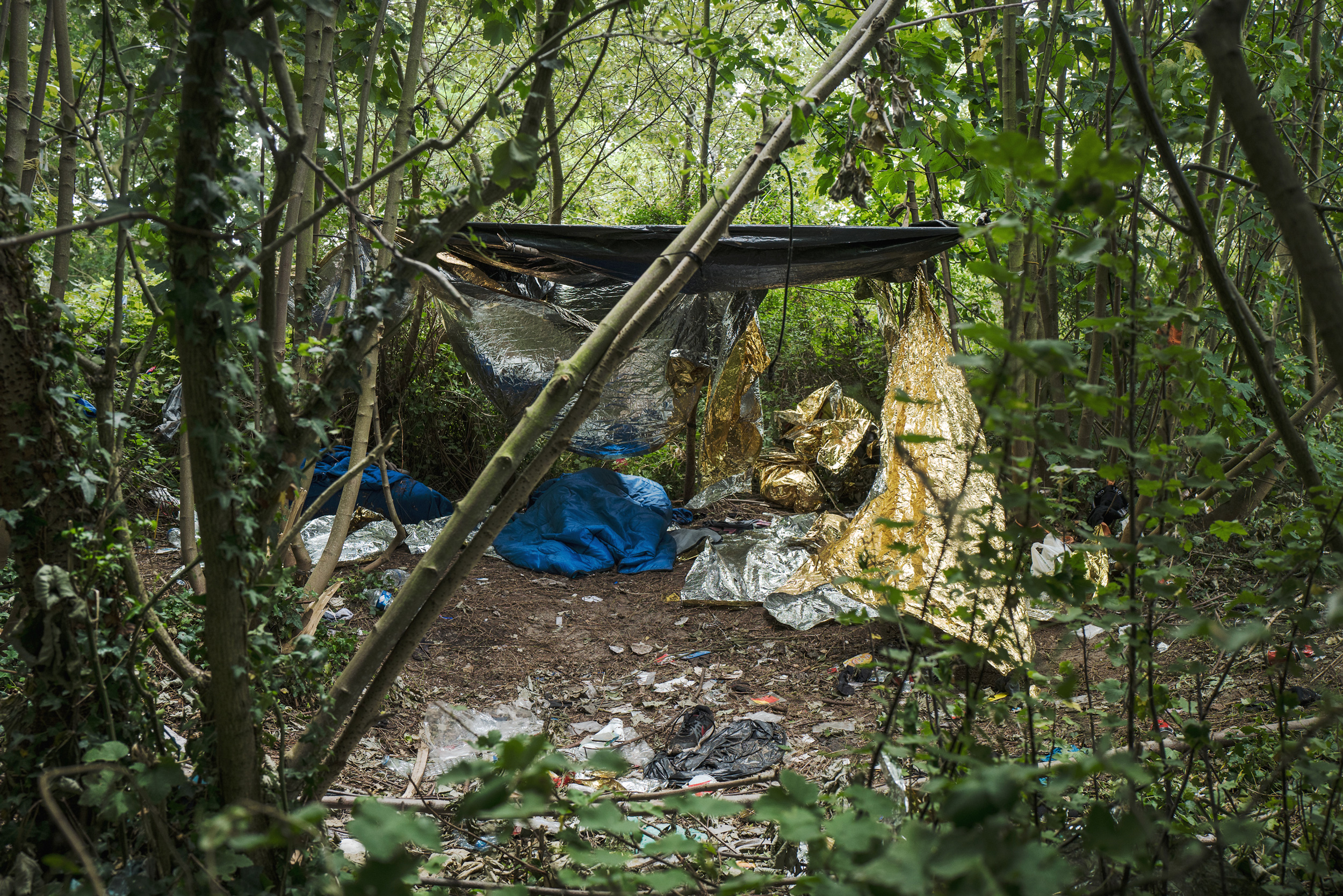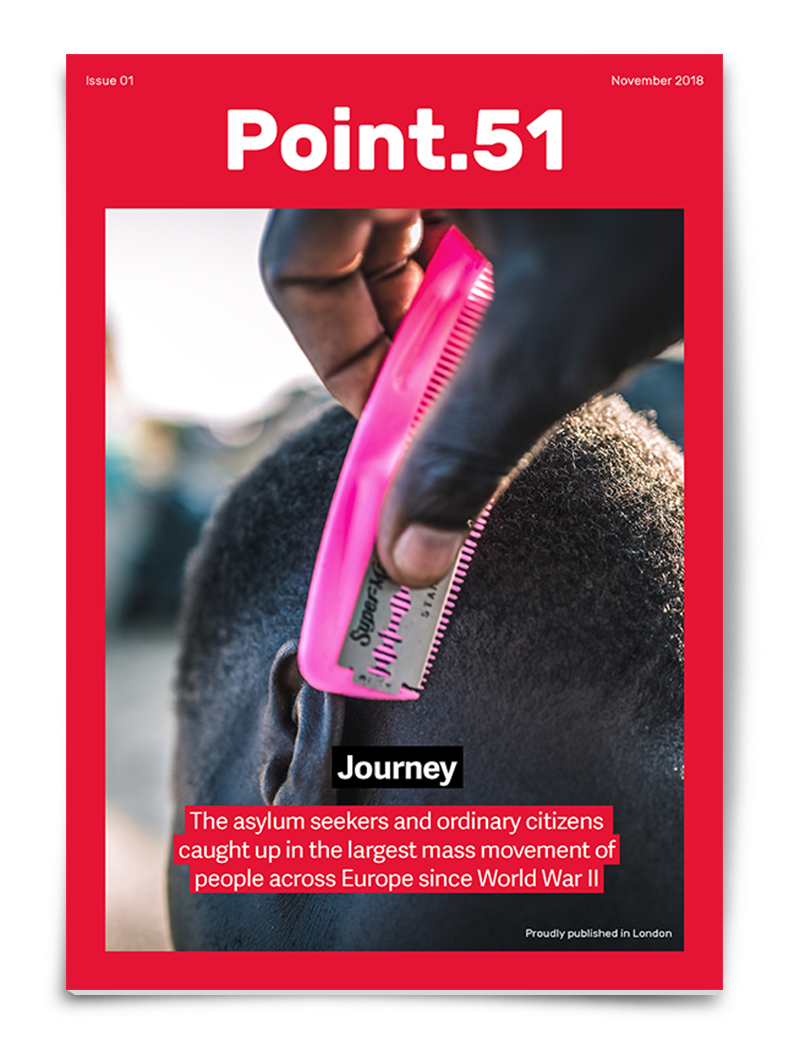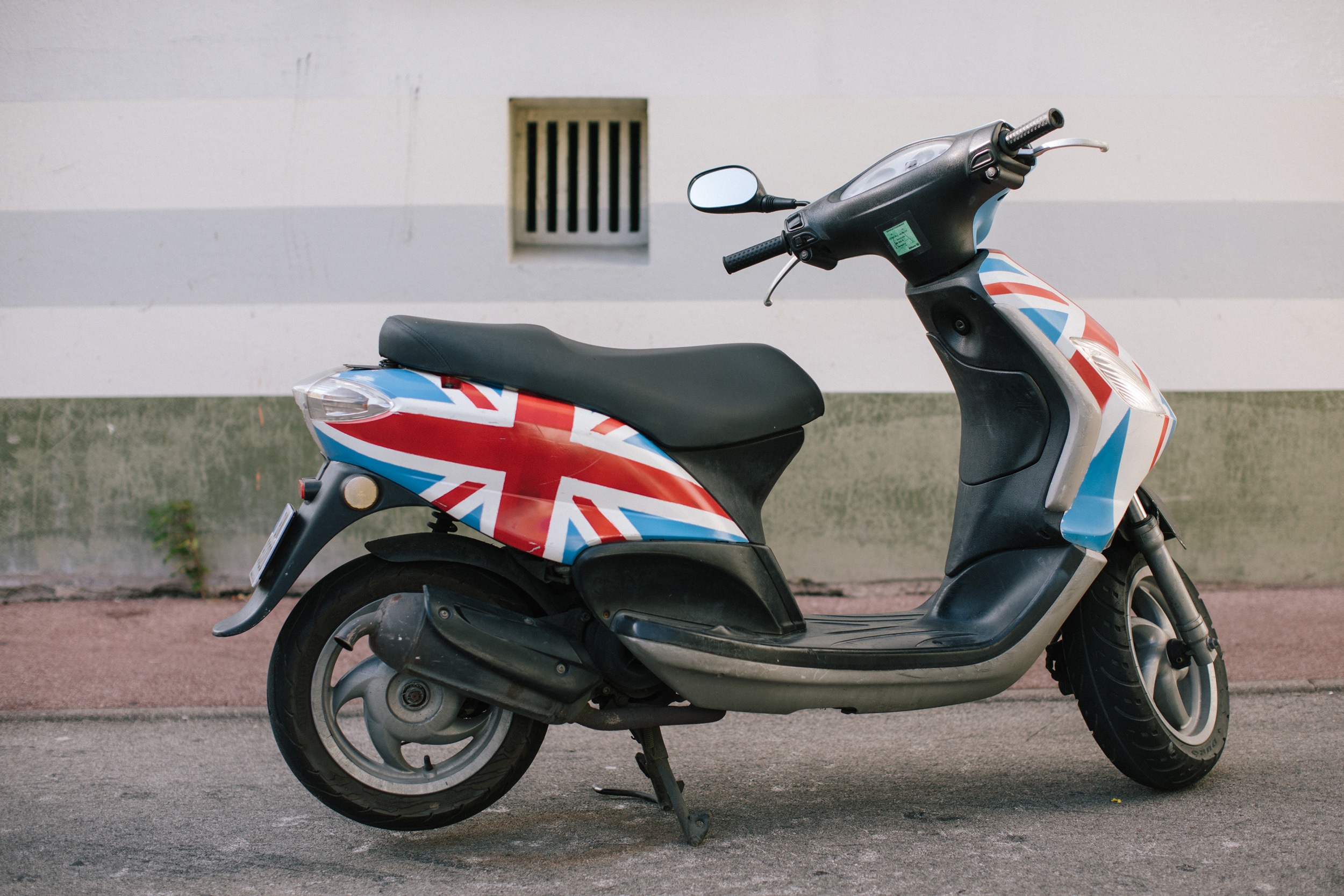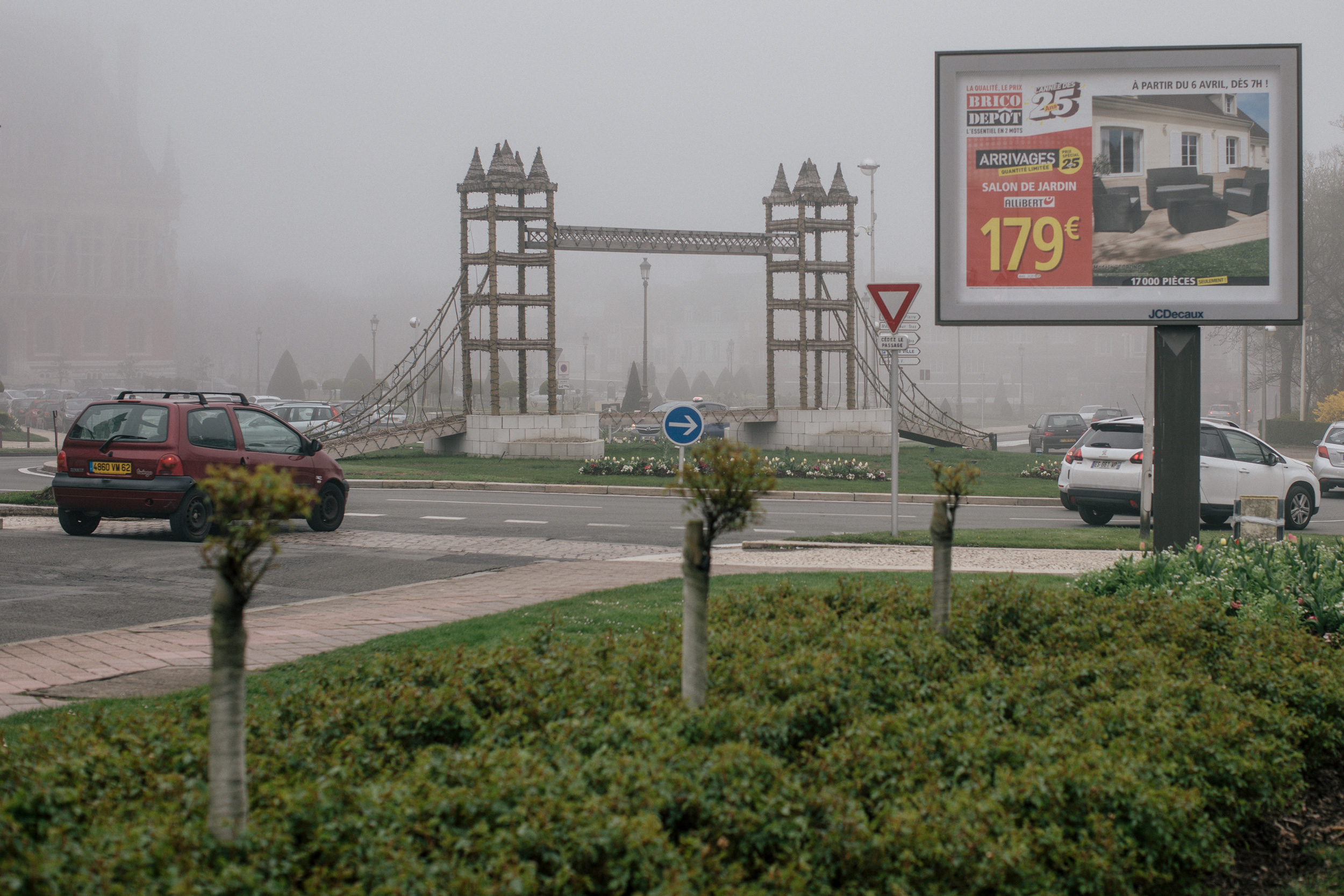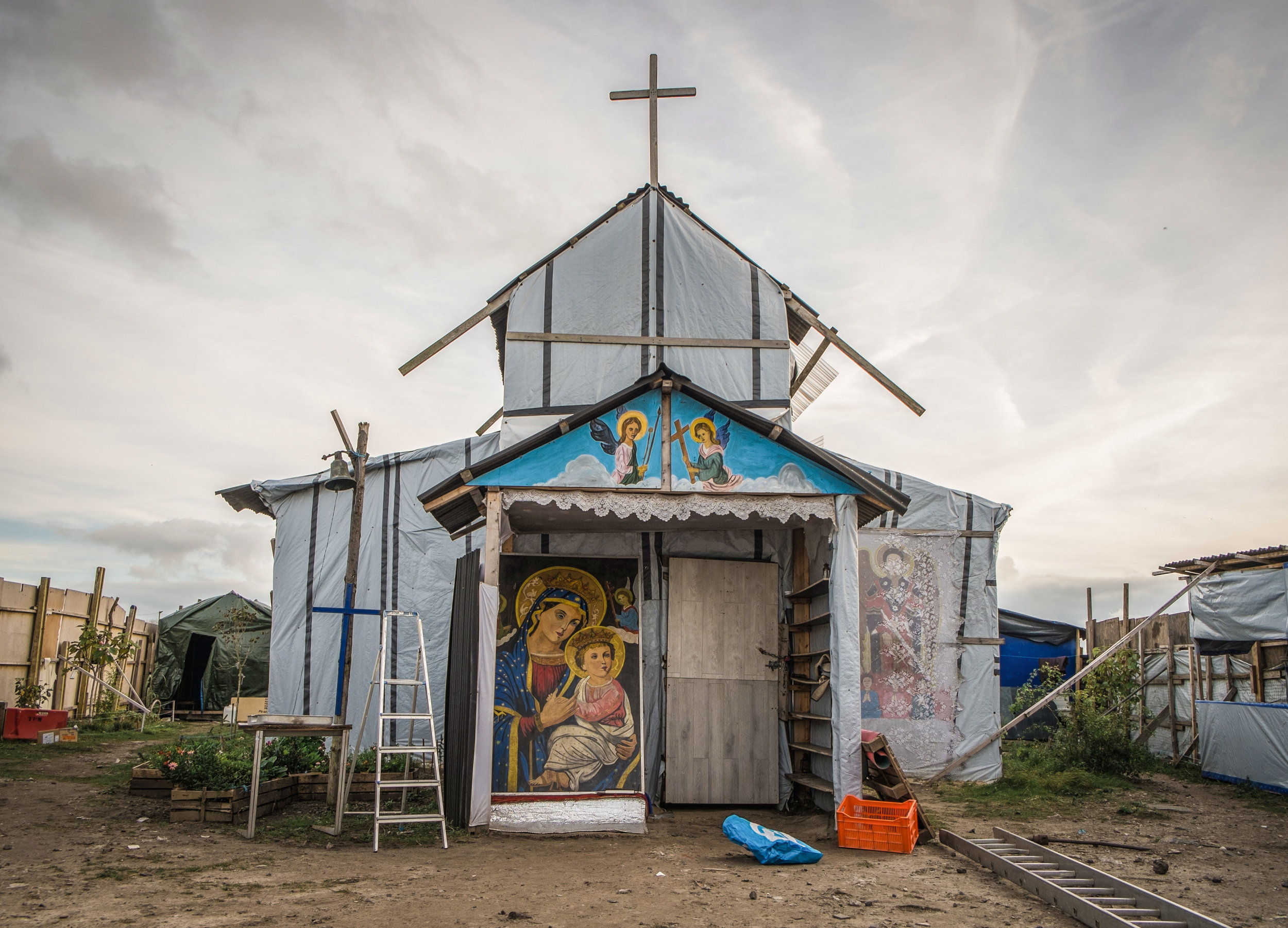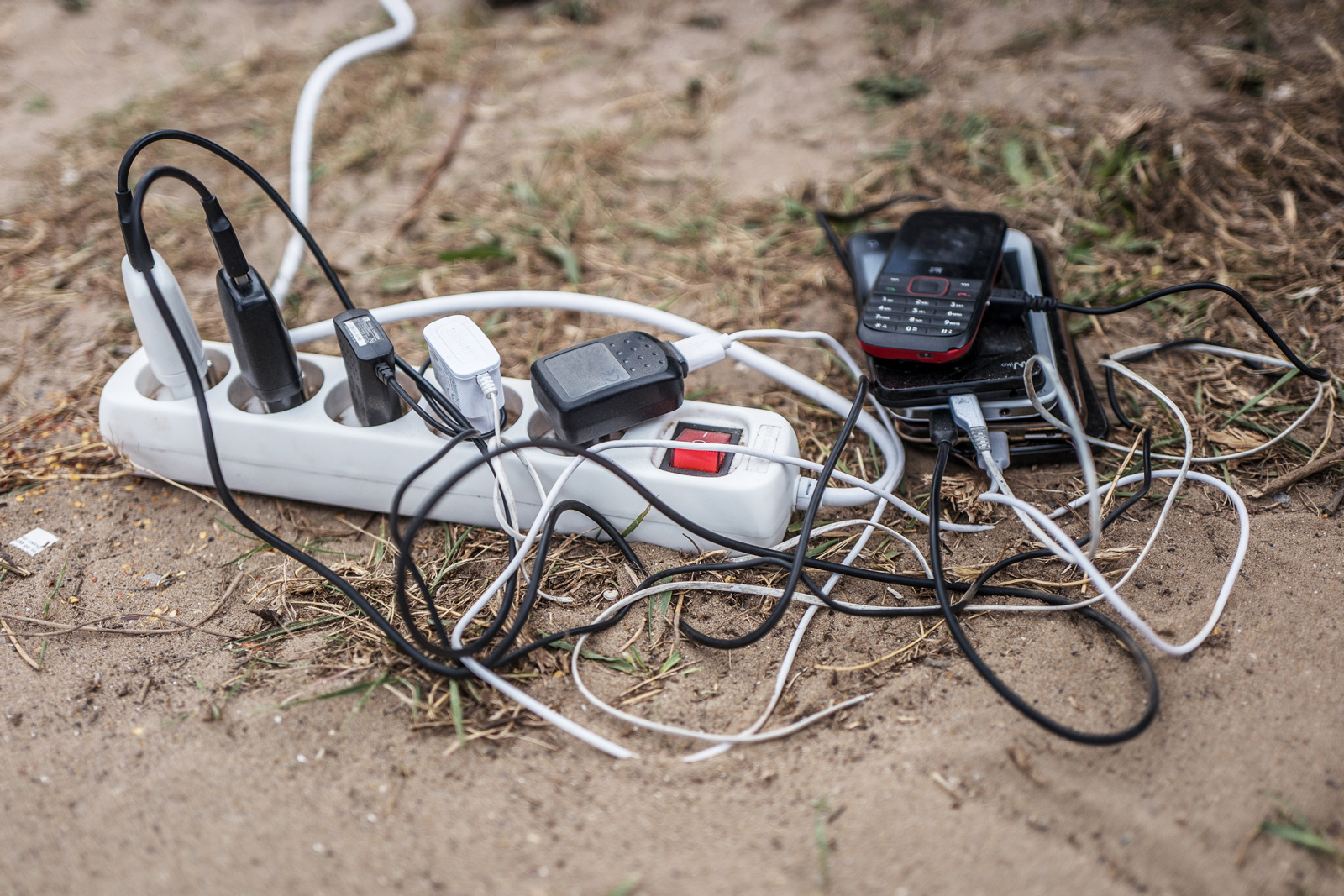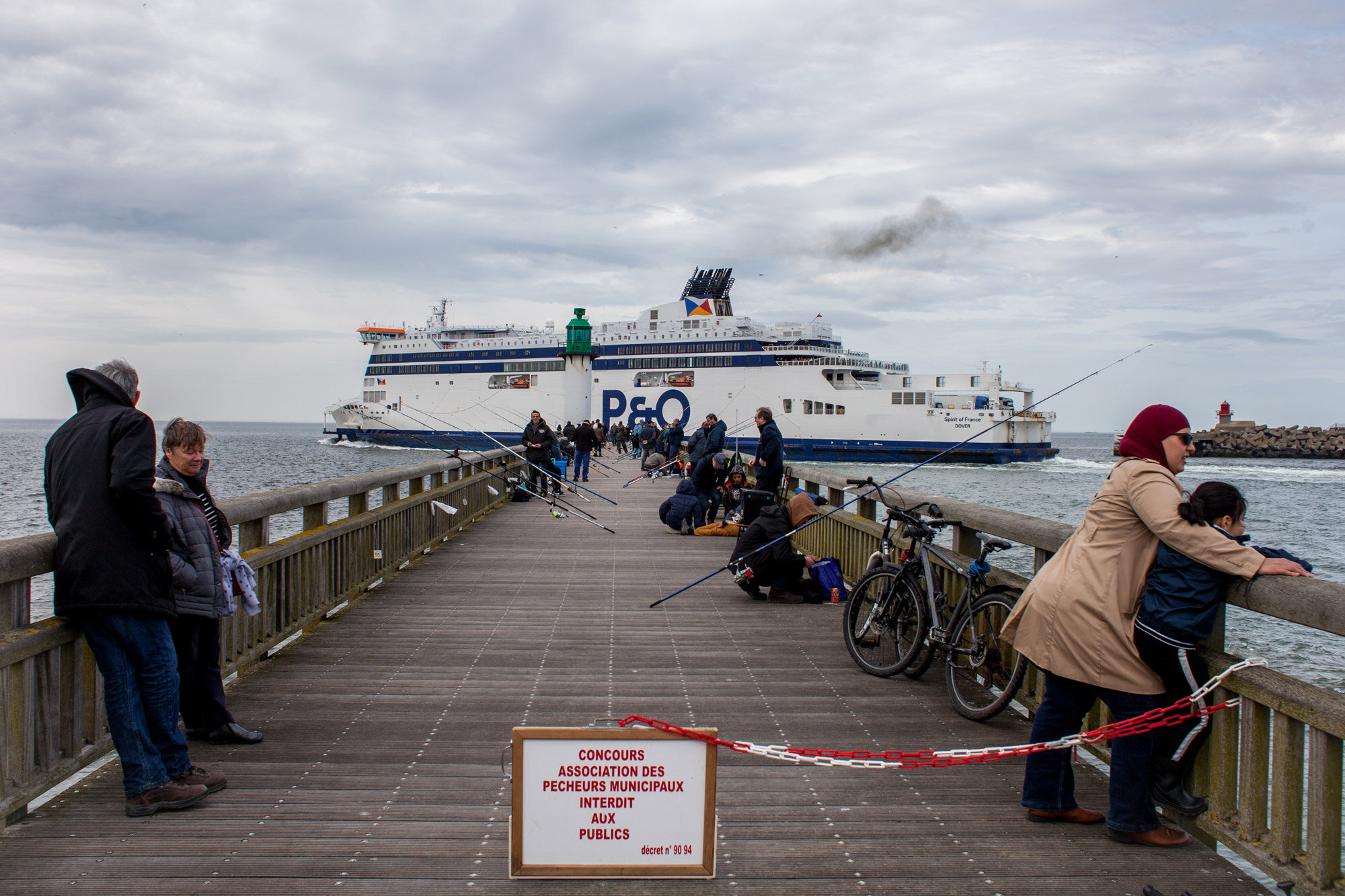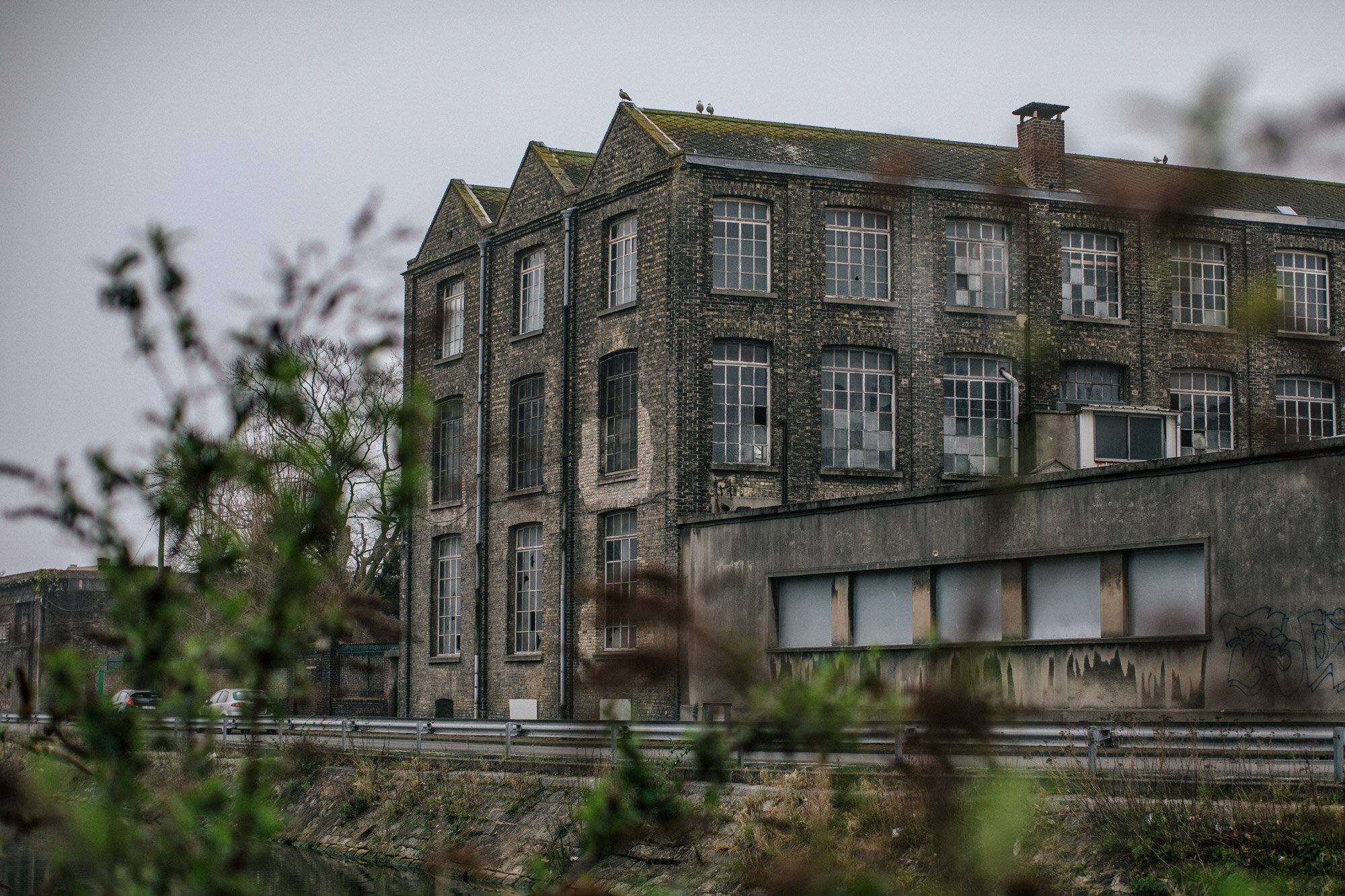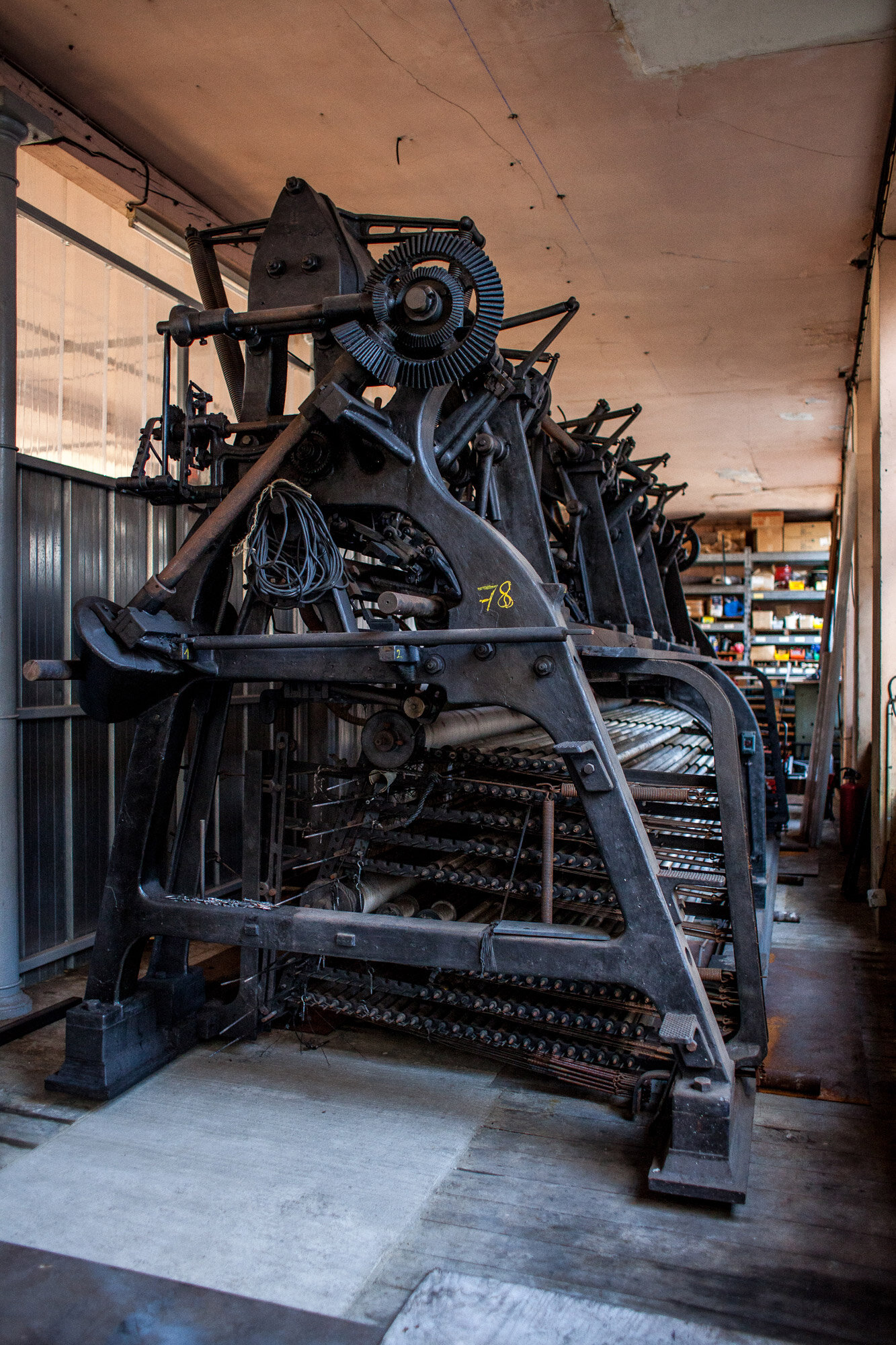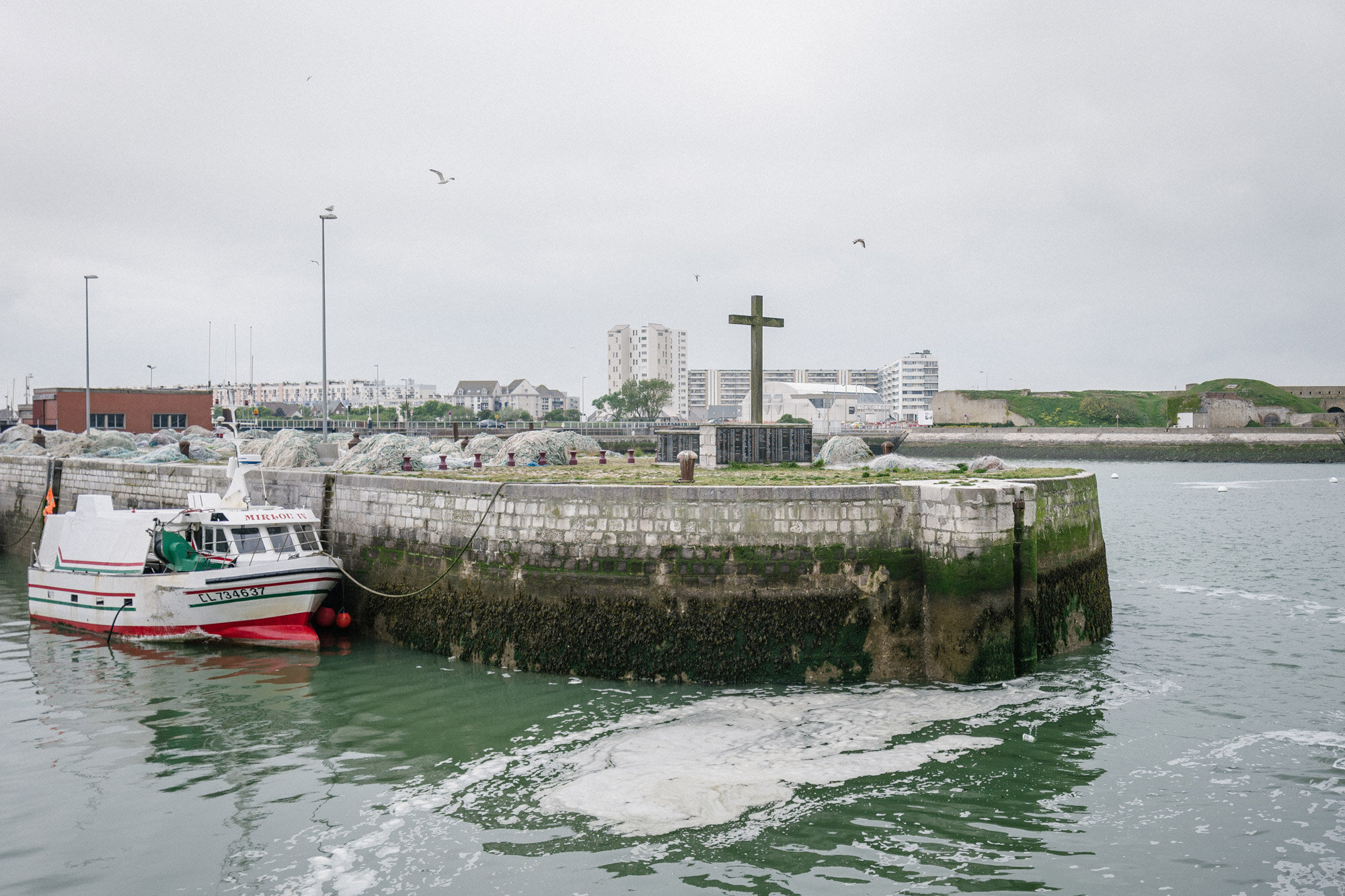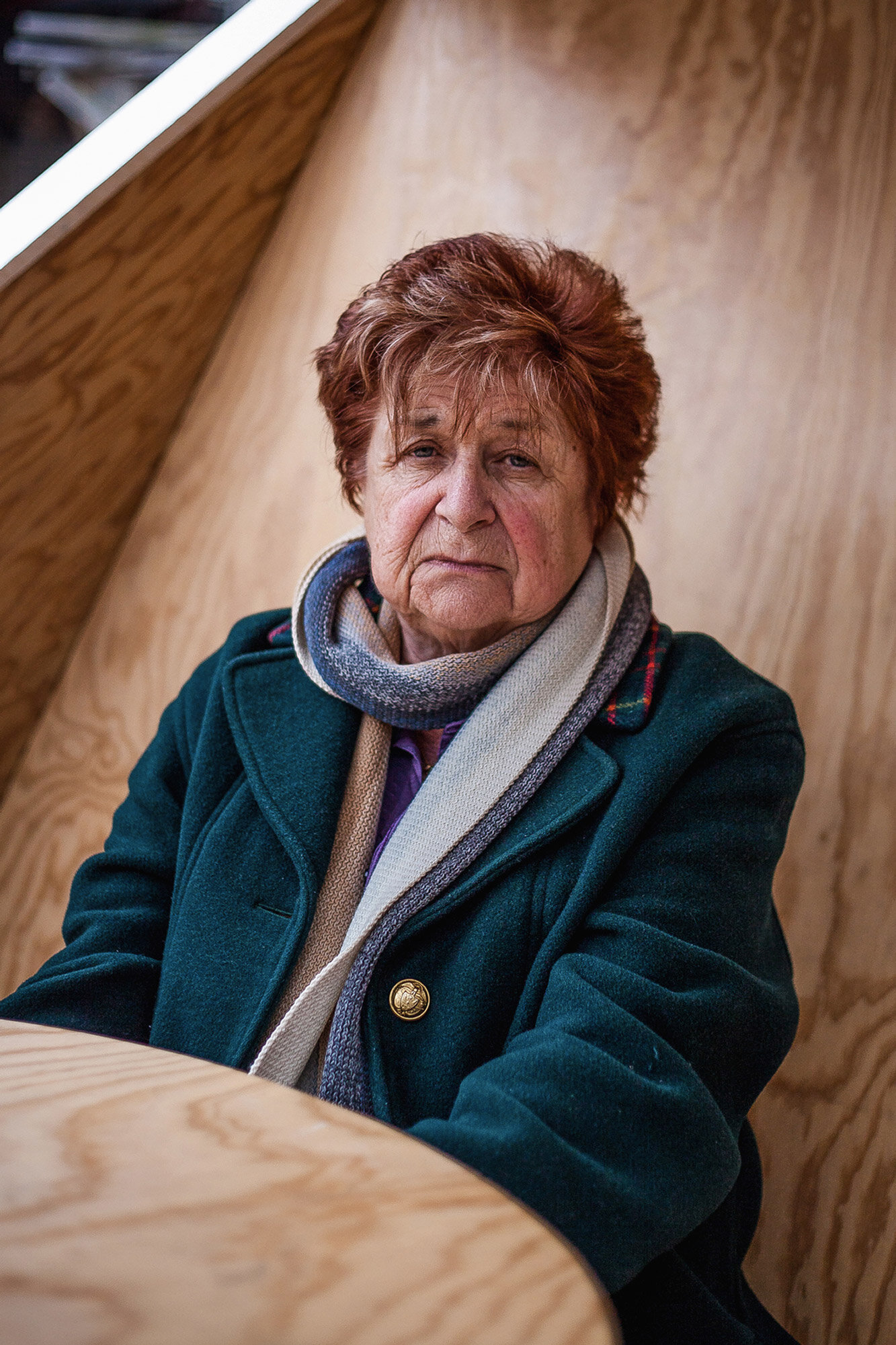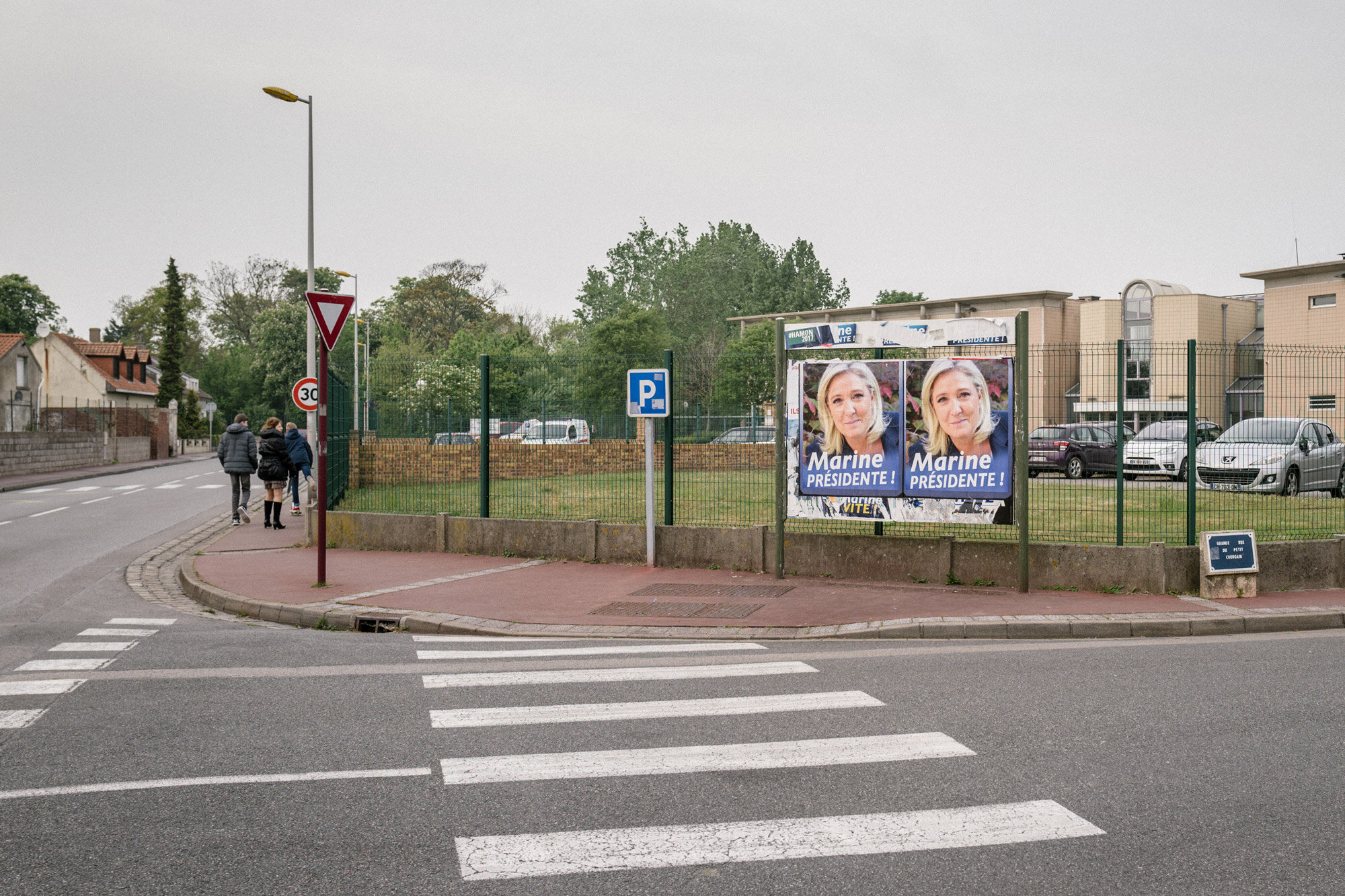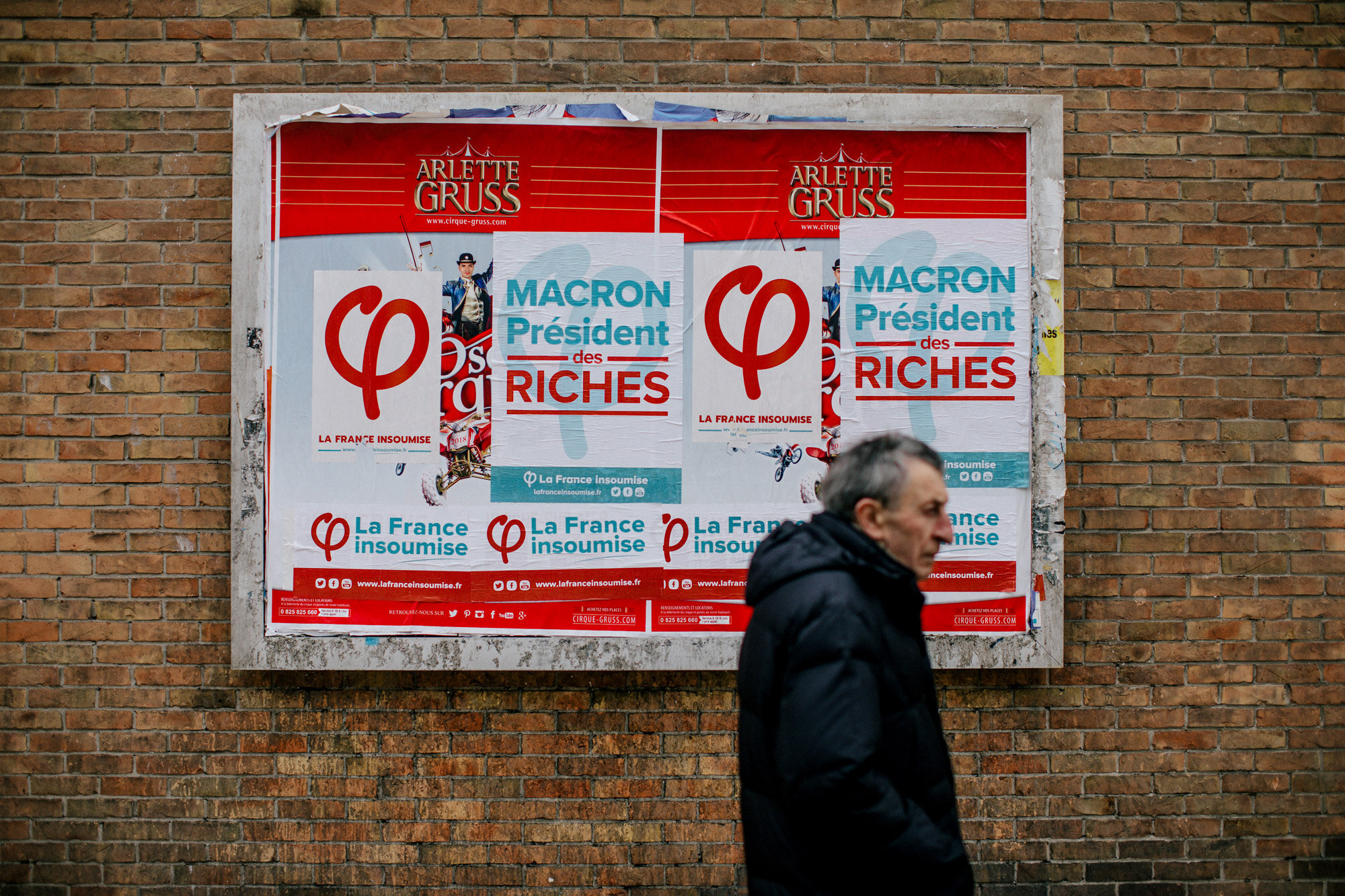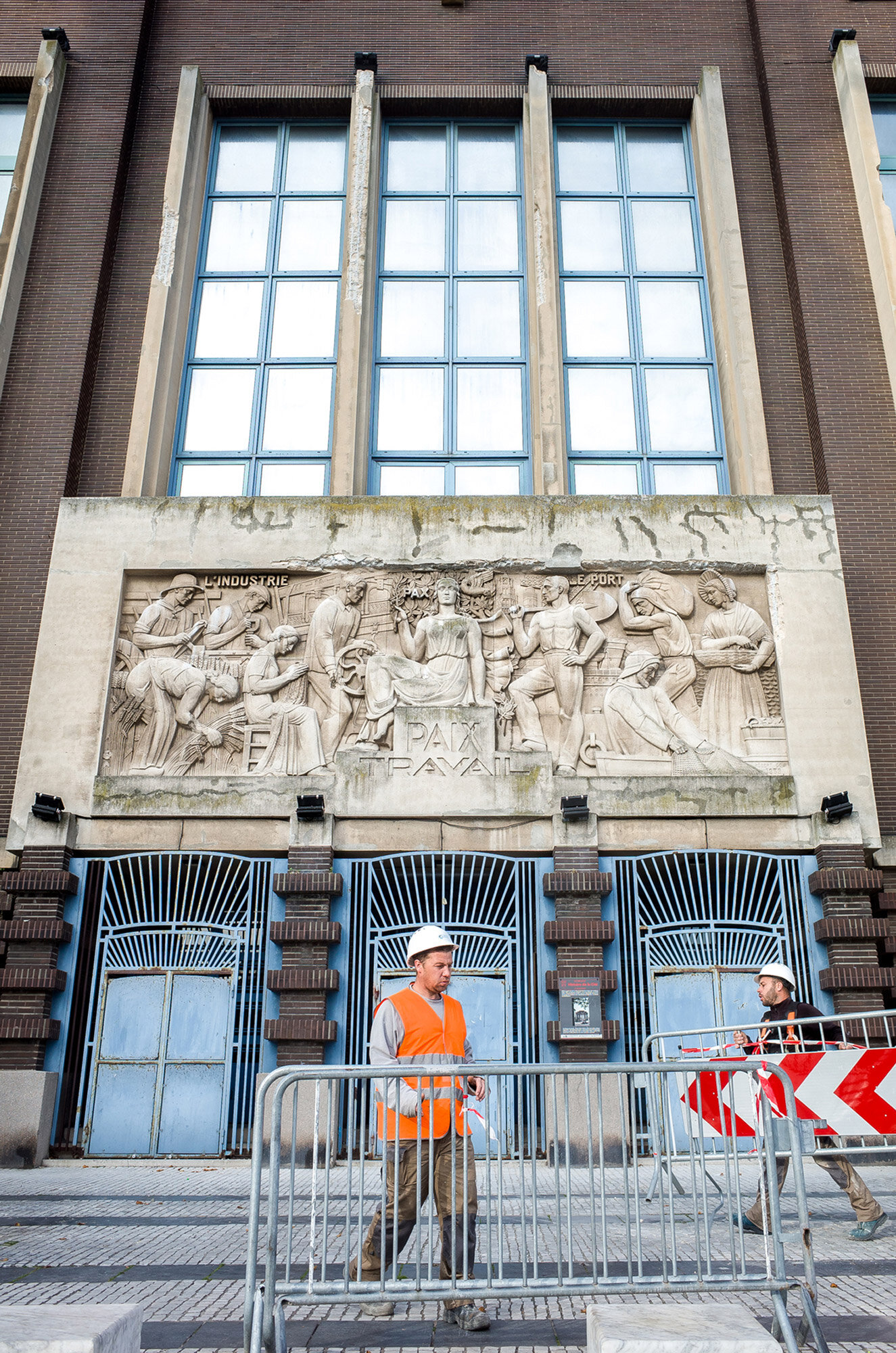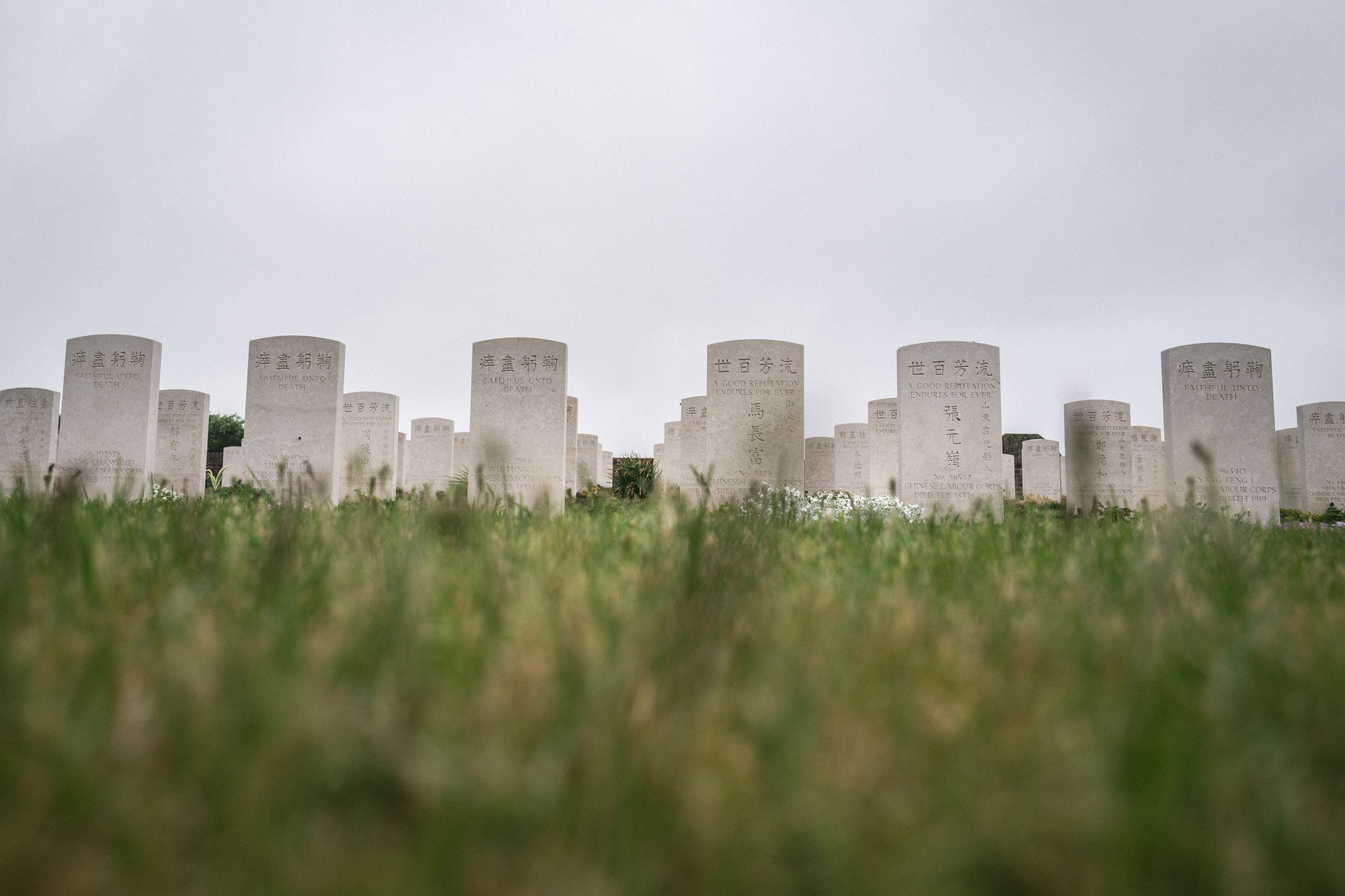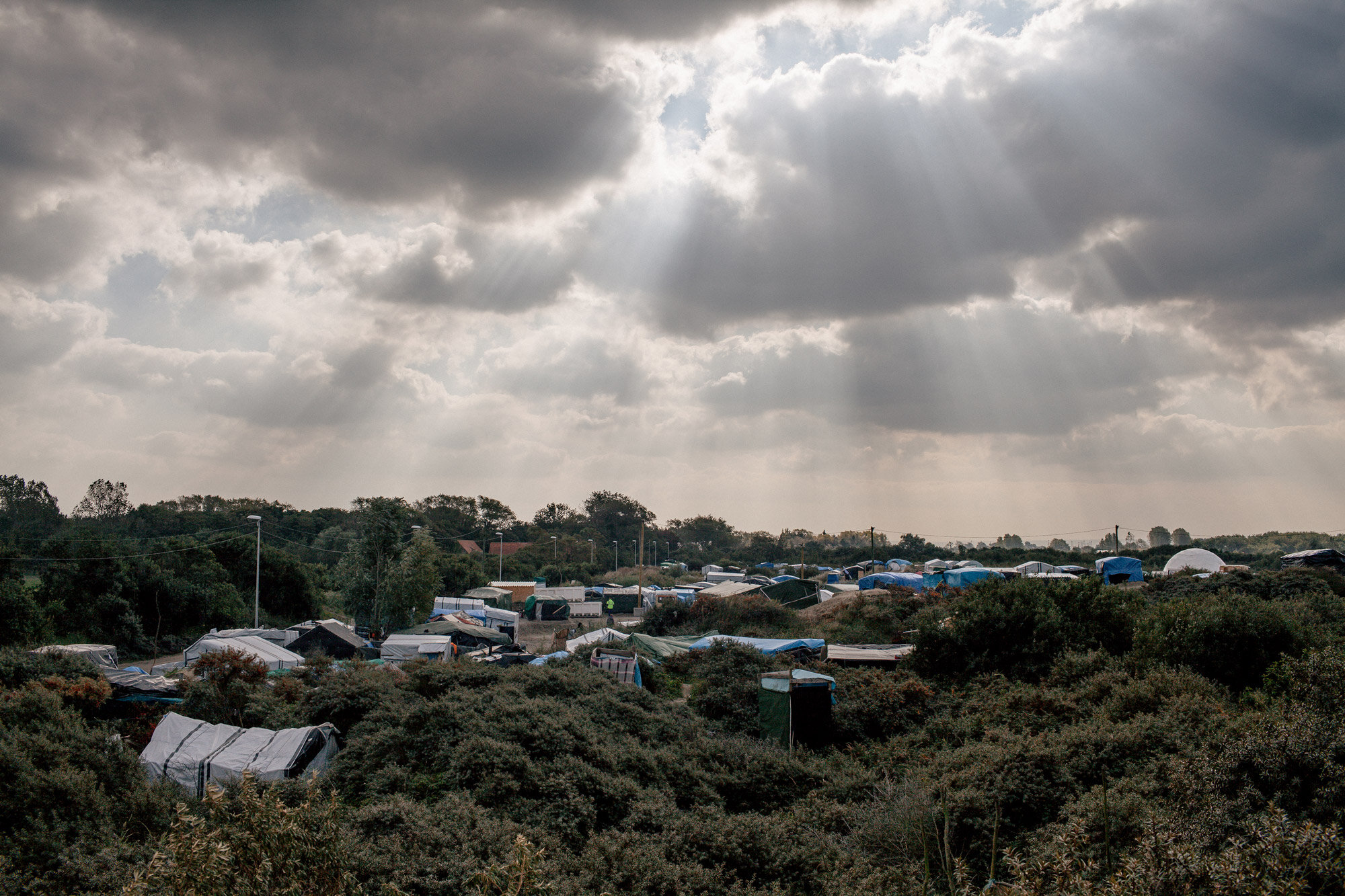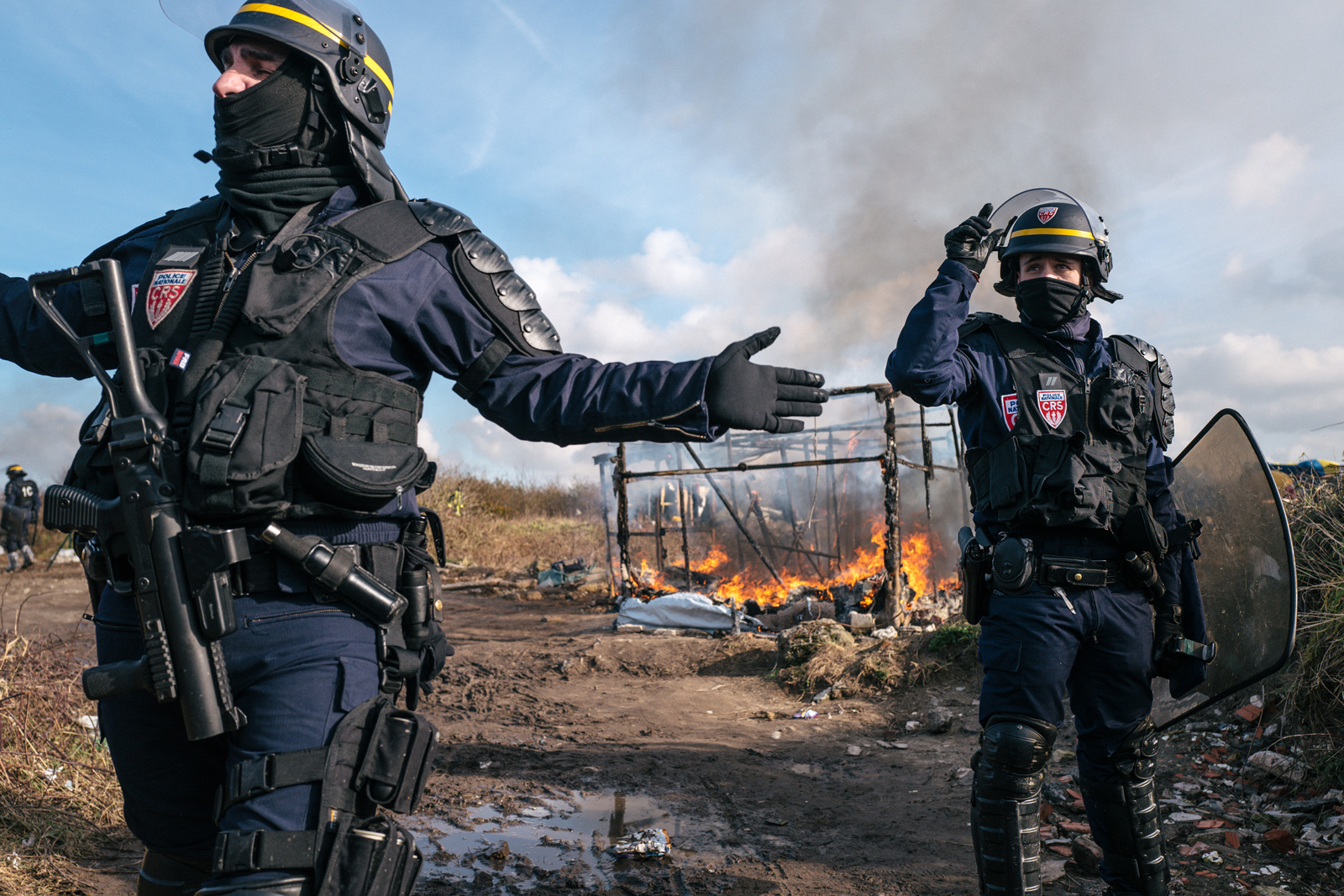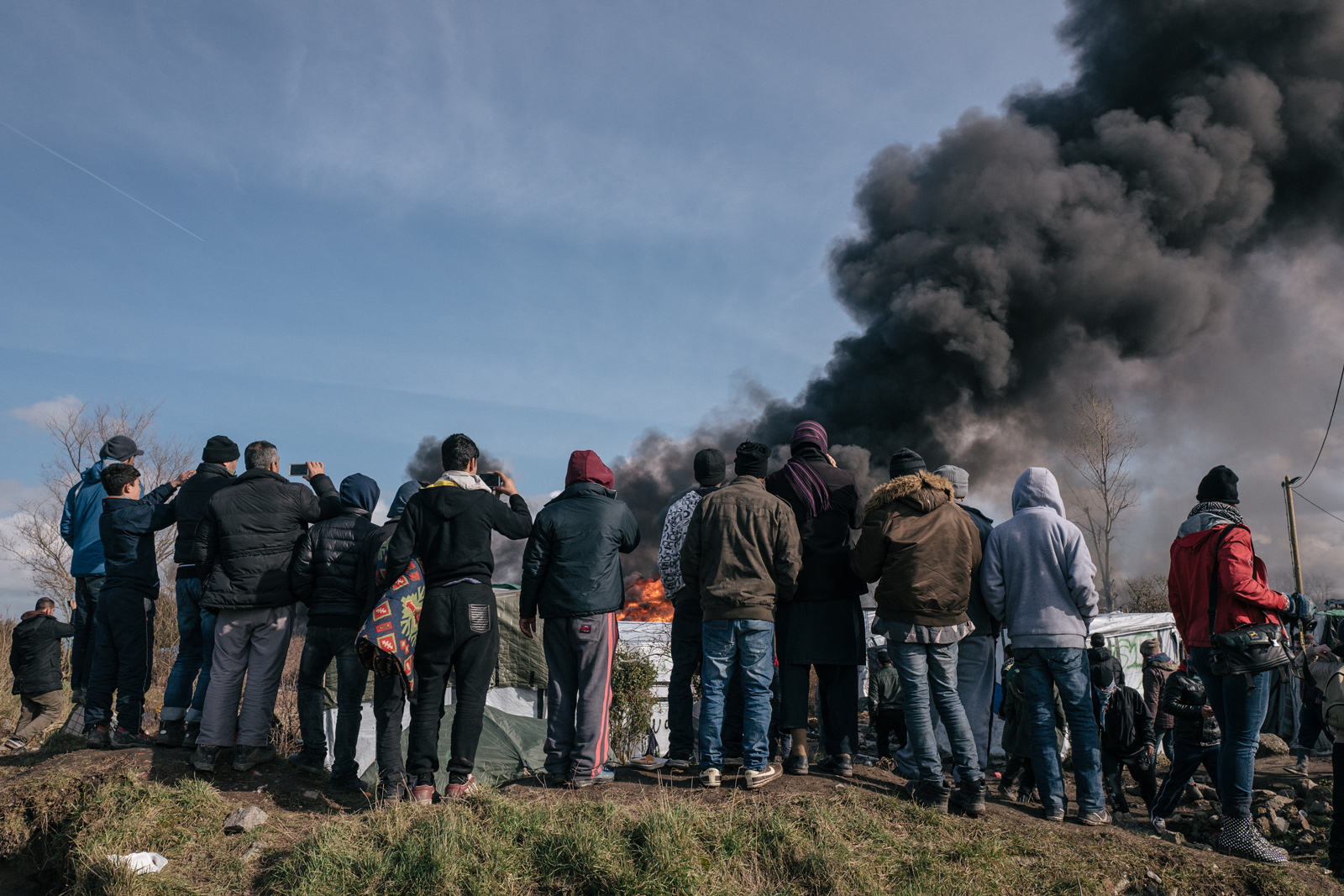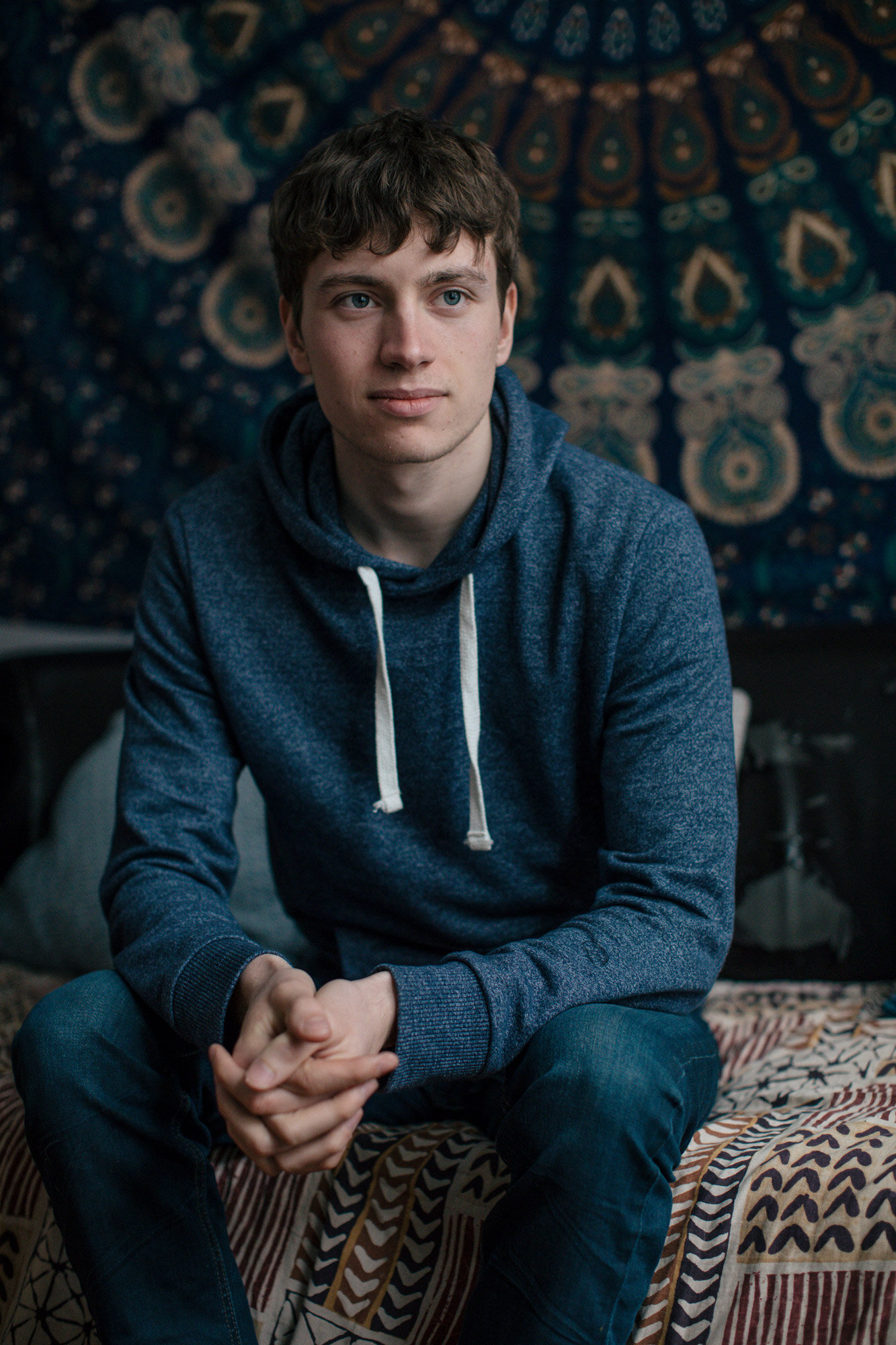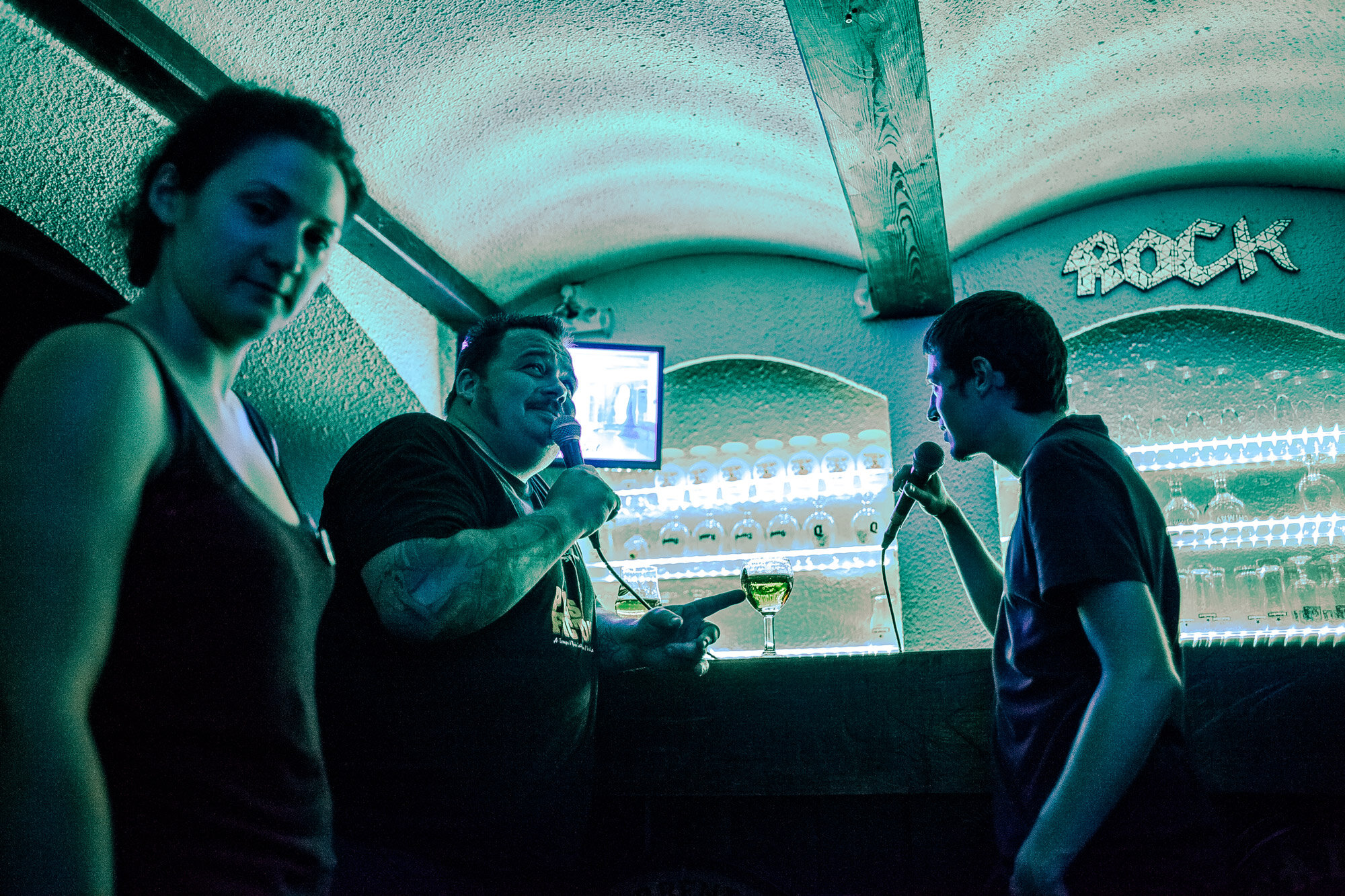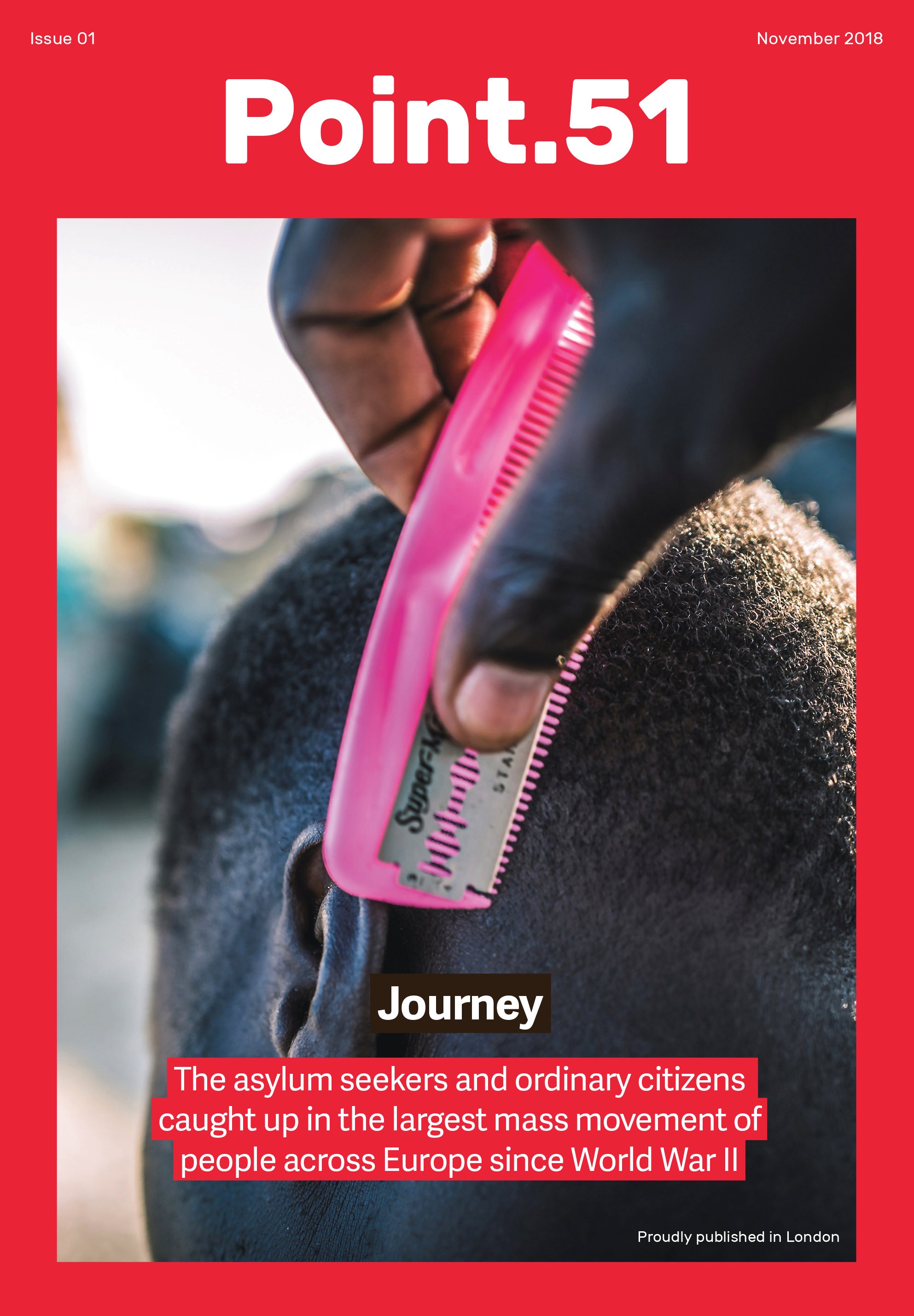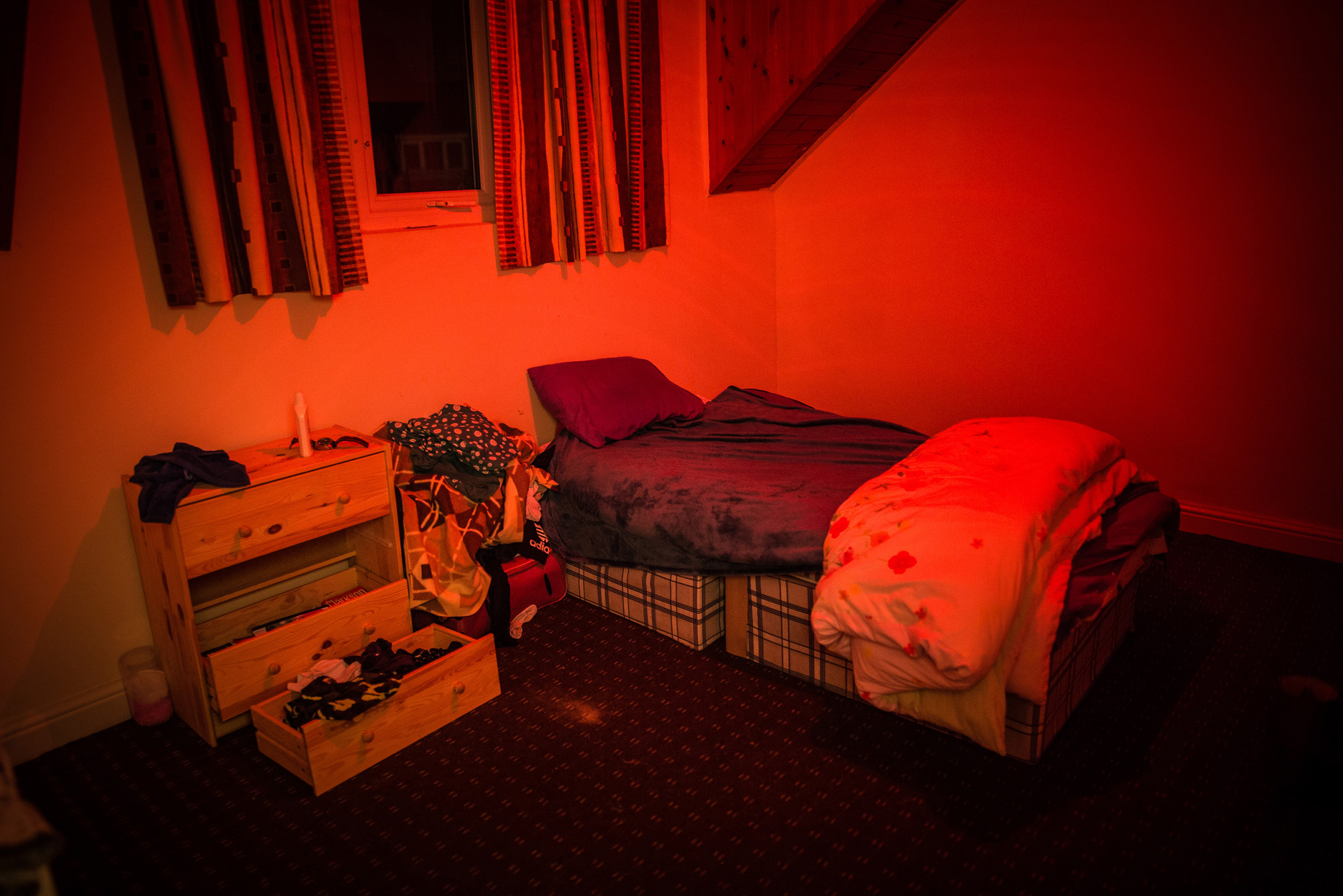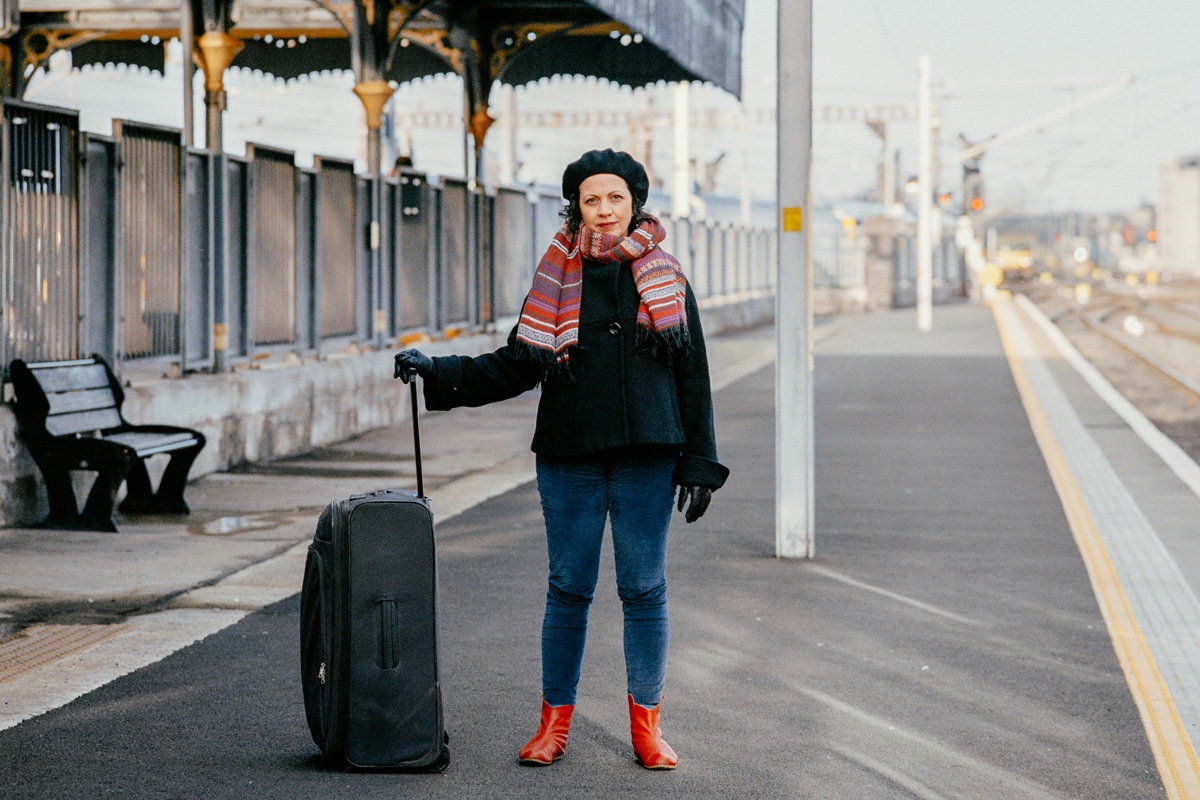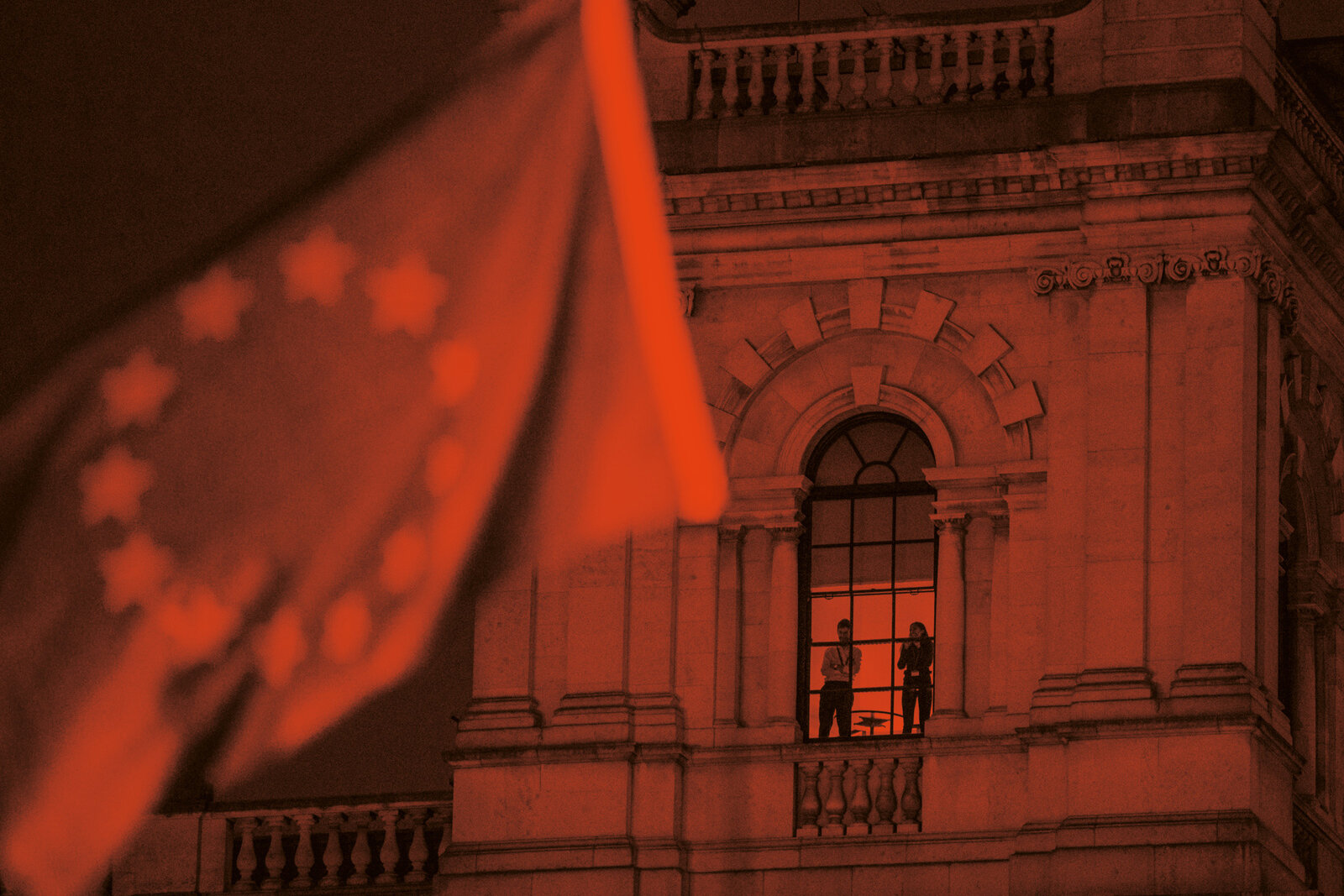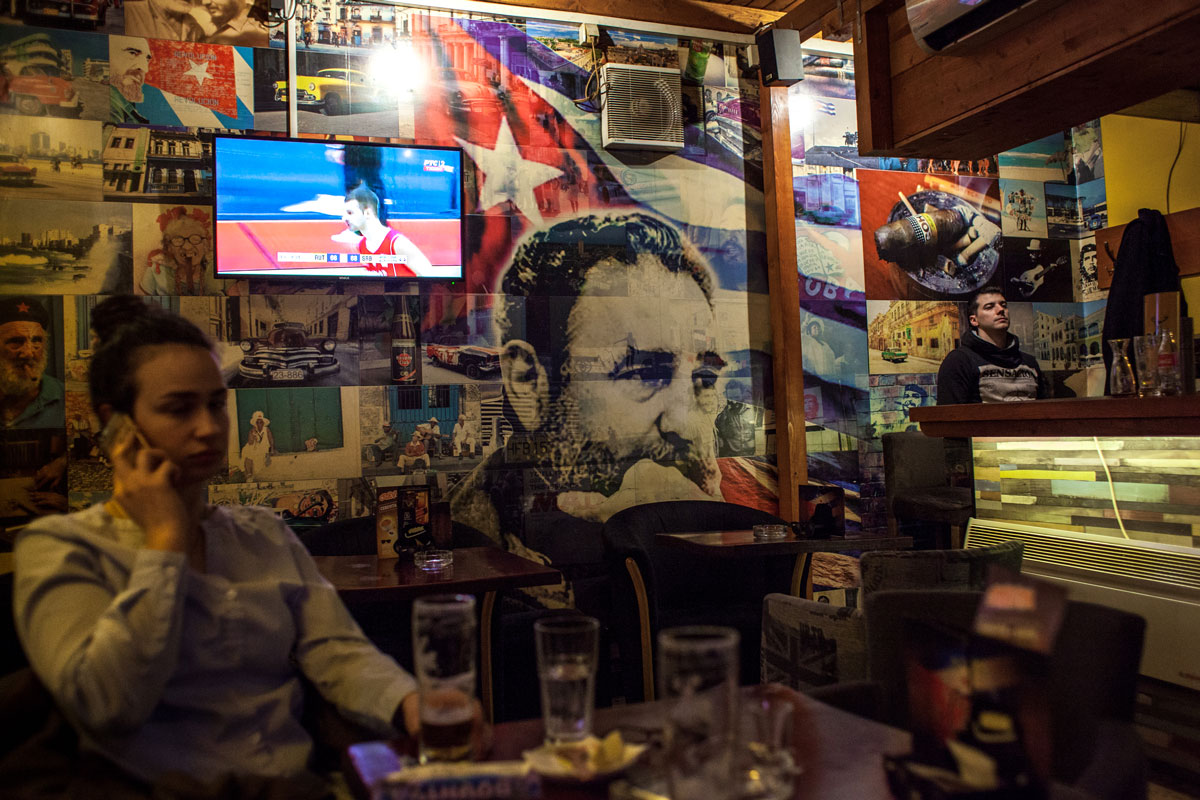Calais Belle Ma Ville
Calais has become synonymous with some of the most controversial aspects of the "refugee crisis". Now, efforts to rebuild a troubled tourism industry are underway – but not everyone agrees on the direction.
On a blustery day in June 2017 at the entrance to Parc Richelieu, two figures, separated by more than a foot in height, stand shrouded in the French Tricolour and British Union Jack flags. Roads have been closed, and occasional passers-by give in to curiosity and approach the two men. The rustling of leaves in the trees overhead is broken by the coarse twang of the tumbi riff in Panjabi MC’s “Mundian To Bach Ke” (“Beware of the Boys”) being carried on the breeze from a stereo in the white apartment block opposite. Crowds begin to gather, some sheltered beneath umbrellas.
“This is an historical day for Calais,” Mayor Natacha Bouchart decrees from a perspex lectern set atop a raised wooden platform. “Calais is about to reconquer its city and place in this coastline region.” A member of the centre-right Les Républicains party, Bouchart was first elected as mayor of Calais in 2008 and later re-elected in 2014. Flanked by a selection of French and British officials, she stands level with the microphone, her shoulders hunched forward, and reads a prepared speech charting her vision for the city’s future. Her words are defiant and optimistic, but delivered with little theatricality. “What matters is this vital link between our ports of Calais and Dover. What matters is the technical feat of the Channel Tunnel … What we want to restore and develop is this reflex action to come and go more frequently between the Cote d’Opale and Kent.”
Statues of Winston Churchill and Charles de Gaulle shrouded in the Union Jack and Tricolour flags in Parc Richelieu in the centre of Calais, France Photograph: Rob Pinney for Point.51
The national anthems of France and the United Kingdom are played and, to broken applause, the covers are pulled away, revealing statues of Charles de Gaulle and Winston Churchill – two wartime leaders often in opposition to one another, but united against Nazi Germany – stood side by side. In front of them, a gateway of white steel structures traces the contours of France. Within each structure, the northern border gradually recedes – sculptor Patrick Berthaud’s rendering of the mayor’s aspirations. But it could just as easily have been groups of Chinese tourists attending the statue unveiling that day. According to a local news report from October 2016, titled “A Statue of Mao in Calais?” City Hall had explored the possibility of commissioning a sculpture which showed a fictitious meeting between De Gaulle and Chairman Mao when De Gaulle formally recognised the People’s Republic of China in 1964. The city also reportedly considered a contract with a tour operator that would bring Chinese tourists to Calais. “It could be compensation for the crisis in our city,” the mayor is reported to have said. The idea was not pursued. As those that had gathered for the unveiling drift away, copies of one of the local newspapers are handed out free of charge. “All You Need is Calais” reads the headline in English.
A moped hand-painted with the Union Jack flag, and the model of Tower Bridge on the roundabout outside City Hall. Photographs: Rob Pinney for Point.51
It is a day that City Hall has been building towards for some time. One thousand free day trips from Dover were offered in a prize draw as part of “Calais Celebrates Summer”, an effort to showcase what the city has to offer in a tentative first step towards rebuilding a troubled tourism industry. Coaches rolled on to early-morning ferries at Dover – the port city just across the English Channel, or La Manche (“The Sleeve”) as it is known in French – bringing the winners of the prize draw over for the day.
But walking along the Rue Royale, one of the city’s main commercial streets, the slogan “All You Need is Calais” rings hollow. As light rain falls from a matte grey sky, scattered groups of British visitors – easy to spot with their “Discover Calais” baseball hats and “Welcome to Calais” tote bags – wander largely empty streets. Some shops are open and have laid on special discounts for the weekend’s visitors, but others are shut and have notices pasted on the windows that read “fermé définitivement” – definitively closed. At its northern end, the street opens out onto Place d’Armes where Union Jack flags hang from the awnings of the restaurants and bars that dot the edge of the square. But they are mostly filled with bemused Calaisians, unsure of what to make of the imitation red telephone boxes that have suddenly appeared on street corners and the scale model of Tower Bridge, made from bamboo and wicker, installed in the middle of the roundabout by City Hall.
Revitalising the city’s troubled tourism industry will not be an easy task. Although not mentioned by the mayor – and noted only in passing by the British Ambassador, Ed Llewellyn, who commented on the improved “security situation” compared with the previous summer – in the minds of many potential visitors Calais has become known for one thing: the presence until October 2016 of Europe’s largest shanty town – the “Jungle” – and the daily attempts of its residents to reach the UK.
St. Michael’s Church, one of the first and most recognisable structures in the “Jungle”. Photograph: Julia Druelle for Point.51
The following day, a short distance across town on a dusty strip of land at the edge of an industrial estate, pop music plays from the front of a van. A large group of men and boys stand in line as volunteers from the Refugee Community Kitchen unload metal dishes of vegetable stew, arranging them on a fold-out table set between two towering electricity pylons.
After the demolition of the “Jungle” in October 2016, most of its former inhabitants left Calais. But many have now returned – between 350 and 800 depending on who you ask – taking shelter wherever they can find it, within the woods that surround the easternmost edge of the city.
There is a sense of excitement in the air. It is Eid – a Muslim festival which marks the end of the month of Ramadan – though many of the Christians among the largely Eritrean and Ethiopian crowd have planned to celebrate too. But mobile phone batteries are flat, and the generator provided by one of the volunteer organisations has broken down, throwing hopes of phone calls that evening with families around the world into doubt.
Two police vans arrive and the handing out of food comes to an abrupt halt. “Allez, c’est fini” (“Leave, it’s finished”) one officer shouts repeatedly, his baton held tightly to his side as those who had gathered are told to disperse. A recent mayoral decree had banned “repeated, prolonged gatherings”, effectively criminalising the distribution of food to migrants, but was subsequently suspended by a Tribunal in Lille. When asked if the distribution of meals was often interrupted, a long-term volunteer said that it used to be, but not in the weeks since the ban was overturned, and so she didn’t know why it was happening again now. As people edge slowly backwards, away from the police, a palpable sense of tension hangs in the air. But it does so in such a way that suggests both sides know how the encounter will end. The disruption feels performative; familiar to all those involved, and enacted as much to keep up appearances as it is in pursuit of any particular outcome. There is a resigned humour in the air. “But I’m hungry,” one man jokes as he is pushed firmly back. Then, as quickly as they had appeared, the officers turn and walk back to their vans. There are cheers and waves as people race back into line.
An hour or so later, after a series of fine adjustments by an Afghan mechanic, the generator finally sputters into life. Shortly afterwards, a volunteer arrives with a box of four-way plugs which are immediately seized upon and daisy-chained one to another, and a multitude of phone chargers are quickly plunged into their sockets.
Mobile phones plugged in to charge from the generator on Eid.
Photograph: Rob Pinney for Point.51
Nearby, in the back of the Refugee Info Bus — a volunteer-run transit van converted into an information centre on wheels — maps are studied and fingertips run across the borders of northern Europe. Faced with the enormity of just how impenetrable Britain’s border has become, other more fanciful destinations are floated. Greenland is mentioned. Yonas*, a sixteen-year-old who has travelled alone from Ethiopia, stares at the map. “Do you think it is possible to reach the UK by boat from Portugal?” he asks. “Where would you like to go?” he asks the others. Another boy closes his eyes and brings his finger down at random on the map. Everyone laughs.
Outside, a seventeen-year-old Tigrayan boy sits alongside several friends, each with half an eye on their mobile phone as the battery gauge slowly fills from the generator. His ankles are bare, and from beneath a pair of black jogging bottoms matted in dust, a pair of clean, shiningly bright turquoise green jeans cling tightly to his skin. We ask about them, presuming he does this to keep warm – temperatures here fluctuate wildly, and frequently drop below zero during the winter months. But they serve a different purpose. These, he explains, are his “England trousers” – something saved for his eventual arrival in the United Kingdom, but that must be worn each day on the possibility that it might be the day he successfully crosses the Channel in the hope of starting a new life.
• • •
TEN MONTHS LATER, in April 2018, we return to Calais to see what, if anything, has changed. On a Monday afternoon, we arrange to meet Qurenso*, a young Ethiopian Oromo asylum seeker, at a small shopping centre opposite the old theatre. But having spoken only on the phone, we do not know who to look for. At one end of the shopping centre there is a Carrefour supermarket, and at the other, a gym with floor-to-ceiling glass windows broken up by adverts showing introductory offers printed over chiselled torsos. A number of the units in between are empty.
Around twenty minutes pass. We call the phone number we have spoken to Qurenso on before, but a friend of his answers – it is his phone – and tells us that Qurenso is on his way. Moments later, a young man wearing a red hooded jumper and a necklace of prayer beads tentatively approaches us. Qurenso is twenty-three, though looks at least a few years younger. We find a table next to the window in a small café with red plastic seats and an array of ready-made snacks in a refrigerated counter. We order tea and coffee; Qurenso takes his tea sweet, and empties several sachets of sugar into his cup.
“It is a very bad situation, very bad for everyone”, Qurenso tells us, explaining that the situation for asylum seekers had become considerably harder since the start of the year. Before, Qurenso says, the police had made little effort to control access to “the try area” – a stretch of tarmac where lorries frequently park overnight before being loaded onto ferries that cross the English Channel to the UK. But now, things have changed. “Everywhere is controlled now. One hundred per cent. But sometimes he is tired,” Qurenso tells us, using “he” to refer collectively to the police. “He is human you know. So when he is tired, we try. When he goes for thirty minutes or fifteen minutes, we try.”
In 2015, when the development of the largest and most recent “Jungle” was only just beginning, it was commonplace to see a slow exodus of men beginning the four-mile walk to the EuroTunnel in the later hours of the night, all hoping for the chance to “jump” passing trains headed to the UK. But investment in the security infrastructure at both the port and the entrance to the EuroTunnel in the years since has severely limited the options for those seeking to cross the border. According to an interview with Ed Llewellyn, the British Ambassador to France, published in the local newspaper La Voix du Nord in February 2017, £63m has been invested by the British government since 2015 to secure the port. Now, for most asylum seekers trying to cross the border from Calais, to “try” means to climb into the back of a lorry in the hope that it is headed for the UK.
Qurenso describes some of the lorries he had managed to get inside, and where he had hidden. “In the carton, in the box, in the fridge sometimes – [with] tomatoes, potatoes”, he says. “It is cold, it has killed people sometimes. I am not getting in the fridge,” Qurenso tells us, referring to the refrigerated containers used to transport fresh produce. But once stowed away inside the back of a lorry, his chance of success comes down to little more than luck. “Some lorry drivers are good, some are not good,” Qurenso says. “When the lorry driver sees me, he stops in a police area and says a person is inside my lorry. But the good one will not say anything and go to the port.”
When he gets a “good one” and reaches the
port, Qurenso tells us that there are then multiple security points he has to pass through undetected if he is to make it aboard a cross-Channel ferry. “At the last one, there is a little dog – a very little but very smart dog.” With his fingers spread, Qurenso hits the palm of his hand against the table, tapping out the rhythm of his words as a grin breaks his otherwise reserved expression. “I win every point, and then that dog is getting in. She comes and stops on my head or on my back … When I am caught, she comes and says ‘Hello’.”
Although each of Qurenso’s encounters with the dog mean another failed attempt to cross the border, he doesn’t hold this against the dog. “I love that dog, she is very smart,” he says. “She is working, it is her job. I am not angry at that dog. My problem is only with the police.” “How many times has that dog caught you?” we ask. “Forty-one times,” he replies.
The changes that Qurenso has seen during the time he has spent in Calais reach further than the increased security around the port and the “try area”. He has found that simply staying in and around the city has become much more difficult. “Macron came one time,” Qurenso says, referring to a visit French President Emmanuel Macron made to Calais in January 2018, “and after he was gone, all the rules changed … The border is very closed.”
There had been hope that comments made by Macron shortly after his election victory over the Front National candidate, Marine Le Pen, signalled a possible shift towards a more empathetic approach to the country’s asylum issues. Claiming that welcoming asylum seekers was part of the “tradition and honour” of a European nation, Macron said he wanted to see them “off the streets” and “out of the woods”. In August 2017, Interior Minister Gérard Collomb announced that France would welcome an extra 3,500 asylum seekers the following year. But six months later, by the time of Macron’s visit to Calais, the message had changed. In a speech given to representatives of the more than 1,100 police stationed in Calais at the time, Macron declared that there would no longer be any tolerance of makeshift camps in and around the city, and that those who had continued to stay there had reached a “dead end”. A briefing issued by the Elyseé (the official residence of the President of France) reinforced this message, stating that for asylum seekers in Calais, “the border is closed”.
If one of the goals of clamping down on attempts to cross the Channel from Calais was to push asylum seekers into heading elsewhere, then it has – at least in part – been effective. “Some people are going to Belgium now,” Qurenso tells us. “Belgium is hard, everywhere is hard for refugees. But when you stay here, the government is not accepting the people. There is no respect for human beings.”
Now that policing of the border has increased, Qurenso has to remain vigilant at all times. “When we sleep, we are scared”, he tells us. “One hour we sleep, one hour we wake up,” Qurenso explains, and says that those who sleep in the same spot as him under a nearby bridge take it in turns to keep watch through the night. “Maybe this is the rule of France, hurting the people, I don’t know. But I don’t believe in this rule.”
Most of what Qurenso needs day-to-day is provided by volunteer groups. There are hot meal distributions each day, and sometimes clothes are handed out too. Occasionally, he is able to shower and wash his clothes at the home of a volunteer. But beyond those who have come to help, his encounters with people in Calais have been less positive. “His face is not smiling when he sees me,” Qurenso tells us. People have called him a terrorist, but he tells us that he only came to understand what terrorism meant through the news after he arrived in Europe, and that his experience here is far from unique. “All refugees will tell you this,” he claims. “The stress of the Sahara, the stress of the Mediterranean Sea, the stress of our life situation. This is all on our mind,” he adds. “We think about our future you know, and when we think about our future, every side is dark.”
Daily ferries loaded with trucks, cars, and foot passengers travel between the port cities of Calais and Dover, two of the busiest roll-on-roll-off ports in Europe Photo: Julia Druelle for Point.51
IT IS AT THIS POINT that news reports about Calais usually end. Whether through lack of column inches or airtime, or limited audience interest, rarely have reports about the city’s ongoing story with asylum seekers wandered into town and started delving into the background story. This has left many local people feeling frustrated by what they see as a false binary: pitting a seemingly unified and nativist Calaisian community against the city’s more itinerant and imperilled population of asylum seekers. A short walk from the main square, the words “Calais belle ma ville” – a dubious grammatical construction which translates as “Calais beautiful my city” – are graffitied on a wall. But many outsiders have come to regard Calais as more akin to a conflict zone than a typical northern French city.
The frustration Calaisians feel over this seemingly impenetrable narrative is also in part nurtured by the now-distant memory of a time when Calais was known for something else entirely: as an economic powerhouse and world capital of the lace industry. Some of the city’s eldest residents still have memories of when Calais produced some of the finest lace in the world, and the streets were buzzing with the sound of huge mechanical lace machines – so much so that the municipality eventually banned their use at night.
The lace industry first emerged here at the start of the 19th Century when three British citizens – Messrs Clark, Webster, and Bonnington – smuggled two state-of-the-art Leaver lace machines (broken down into several pieces) out of Nottingham in an attempt to escape both a crisis of overproduction in the UK, and heavy English patent licensing taxes for the use of this technology. From 1816, the basis of a thriving new industry emerged, and a number of small production workshops were set up within the walls of the Old City. The lace industry soon expanded into the city’s suburbs, and by the beginning of the 20th Century, it had grown to employ some 30,000 people. The market for this high-quality lace – which would later be given the official label Dentelle de Calais (Calais Lace) – was a global one, and exports were shipped from the port of Calais to all corners of the world.
A former lace factory in Calais Photo: Rob Pinney for Point.51
An old lace machine in a former lace factory Photo: Julia Druelle for Point.51
But for Calaisians today, the lace industry feels like ancient history. From the 1960s, demand began to decline. Some lace factories shut up shop entirely, and others fell victim to globalisation as production was shifted to other parts of the world where rent and labour were cheaper. The industry unravelled, slowly but inexorably dragging down the city’s economy, of which it had been an integral part. As an inevitable result, unemployment rose dramatically. Today, only 600 people still work in what remains of a once-flourishing industry. A museum to preserve the memory of this proud history was opened in 2009, and a few abandoned former lace factories – tall, imposing structures with long cast-iron windows to maximise the amount of light that fell onto the factory floor — can still be found around Calais, rising above the buildings around them like historical gravestones from the city’s golden age.
Alongside lace, the city’s other key industries – notably chemical production and the manufacture of electrical equipment – have also suffered. The construction of the EuroTunnel, opened in 1994, brought with it a brief reprieve as some found temporary work and others benefited from the influx of contractors working on the project, but this was short-lived. In 2000, fourth-division amateur local football team Calais Racing Union FC defied the odds and reached the Cup Finals, pitting them against first-division FC Nantes Atlantique at the Stade de France in Paris. Journalists descended on the town as “Calaismania” took hold, to report on a true David and Goliath story in this “downtrodden port town”. Calais lost the match 2-1.
Today, despite a major modernisation project, the harbour is in difficulty. Although heavy goods traffic increased in 2017, the port has not yet regained the market share it held before 2015, and foot passenger numbers continue to decline. In March 2018, unemployment in Calais stood at 14.2 per cent, well above the national average of 8.9 per cent. One third of Calais’ population is now considered “poor”, living on less than 60 per cent of the national median income, and that figure rises to half for those under thirty years of age.
Against the backdrop of the city’s industrial and economic decline, French street artist Ernest Pignon-Ernest came to Calais in 1975 to create a body of public art that would reflect the prevailing feelings of the population. He glued hundreds of screen prints onto walls around the city, which depicted a man holding his head in his hands, accompanied by a child doing the same thing. In his introduction to the work, simply titled “Calais”, Pignon-Ernest wrote that it had been suggested to him that he spend time observing out-of-work Calaisians at the Agence Nationale Pour l’Emploi (ANPE), then the government department responsible for providing support and counselling to job-seekers – located in the basement of City Hall. “A municipal councillor had warned me,” he wrote, “‘Here, the feeling of resignation is rooted in the chromosomes’.”
In front of this same building, you will find the six Burghers of Calais, a statue by Auguste Rodin which represents an important part of the town’s foundational myth. As the legend goes, the men sacrificed themselves to save the lives of their fellow citizens when the city fell into the hands of King Edward III of England, in 1346. Their lives were only spared at the request of the Queen, which Pignon-Ernest – who drew inspiration from the story – took as an early sign of this “resignation” to fate that he witnessed among the city’s unemployed. Forty years later, Banksy would follow in Pignon-Ernest’s footsteps, stencilling various pieces around the town – including a little girl looking out to sea towards the UK through a telescope with a vulture perched on top of it, and Apple founder Steve Jobs, the son of a Syrian political refugee, carrying a bag – to highlight the ongoing crisis of asylum.
The memorial to fishermen lost at sea Photo: Rob Pinney for Point.51
TO LEARN MORE about how the city got to where it is today, we arranged to meet Bérangère Baude at Le Channel, a cultural centre housed in a former slaughterhouse on the outskirts of town. To get there from City Hall, you head down the Boulevard Jaquard until you reach the Grand theatre, which dates back to 1905 and sits on top of an old cemetery. Legend has it that the cemetery contained the grave of Lady Hamilton – a famous British model and actress who died in poverty in Calais in 1815 to escape her creditors – and that her ghost still haunts the place. But that is another story. At the theatre, you turn right, and continue until the end of the Boulevard Gambetta.
Bérangère Baude Photo: Julia Druelle for Point.51
Bérangère is waiting for us when we arrive, wearing an intense emerald green coat which compliments her mahogany hair. With a cup of tea in front of her, she speaks slowly and enunciates her words to their fullest. It is not hard to believe that she used to be a school teacher. “It was the local priest who made me become communist,” Bérangère declares. “Poor man, if only he had known!” Bérangère is well-placed to tell us about another important but often-overlooked part of the city’s history: Calais was for a long time a communist stronghold – at one point the biggest Communist-led city in the country – until the election of the current mayor in 2008.
Bérangère grew up in Beau-Marais, an impoverished neighbourhood in the southeastern part of the city where the consequences of Calais’ economic misfortune were especially felt. “Right after the Second World War, Calais was Gaullist,” she recalls, “especially since Charles de Gaulle had married a woman from the town – Yvonne Vendroux.” A statue of the couple, arm-in-arm, still stands in the Place d’Armes, the town’s main square. After the war, Yvonne Vendroux’s brother, Jacques Vendroux, was elected mayor, and when De Gaulle came to visit, Calaisians lined the streets to welcome him. Bérangère puts his popularity at that time down to the widely-held belief that he was responsible for the liberation of France. But she is not convinced. “De Gaulle was a great politician … But he wasn’t the one who coordinated the resistance; Jean Moulin did that,” Bérangère tells us, referring to the dashing left-wing resistance leader who died in 1943 whilst in the custody of the Gestapo.
The Algerian War, which had as deep an effect on French society as Vietnam did for America, seemed to be the turning point, Bérangère tells us. “In 1962, people understood that the only ones openly opposed to the war were the Communists,” she says. “I wouldn’t say that they took the side of the Algerians, but they started to see deaths among soldiers that they knew.” In 1971, the Communist Party won the municipal elections, and Jean-Jacques Barthes became the Mayor of Calais. He remained in office for twenty-nine years, and was followed in 2000 by Jacky Hénin, also from the Communist Party. In an impoverished and then-largely industrial town, the Communist Party's popularity was in many ways not surprising, especially as local socialist leaders had worked hard to organise workers unions since the end of the 19th Century.
Election posters in Calais in the run-up to the second round of the 2017 French Presidential Election Photo: Rob Pinney for Point.51
But this, too, now feels like ancient history. In 2008, the current mayor Natacha Bouchart was elected, marking a decisive shift in the city’s political landscape. The Communist Party had fallen out of favour, and many voters had moved firmly towards the right. More recent elections show that this trend has continued. In the second round of the 2017 Presidential Election, Marine Le Pen won 57 per cent of the vote in Calais, well above the national figure of 33 per cent. But abstention among voters also reached a record high of 30 per cent, and in the first round of voting (France has a two-round election system), the left-wing candidate, Jean-Luc Mélenchon, also scored highly – gaining more first-round votes in Calais than Emmanuel Macron, the eventual winner.
On the Place Crève-Coeur, a vast square paved in marble, a carved mural – which shows a woman holding an olive branch flanked by port and industrial workers beneath the words “paix” and “travail” (“peace” and “work”) – looms above the doors of the former Labour Exchange building as a reminder of the city’s socialist past.
The mural above the entrance to the old Labour Exchange building on the Place Crève-Coeur Photo: Julia Druelle for Point.51
What caused a city which had consistently voted for left-wing parties for decades to abruptly change course? “There is a belief among many people that if they are suffering, others should be suffering too,” Bérangère believes, “and unfortunately this has happened in the middle of the migration crisis.”
According to Bérangère, high levels of unemployment and the political exploitation of “the situation” in Calais have both contributed towards the shift to a more right-wing political outlook. But she also thinks that many of those who have been persuaded by the rhetoric of anti-immigration politicians do not realise how important the movement of people through Calais has been for the city’s history. “People don’t know about this”, Bérangère asserts. “They have forgotten. This is why I think that history is really poorly taught nowadays. It shouldn’t be a history only of dates and big characters, but a history of people. I think it would be really good to know how people migrated in our regions, and what this brought to us.”
• • •
CALAIS HAS A LONG HISTORY of divided loyalties. For more than two centuries, from 1346-1558, it fell under the direct control of the Kings and Queens of England. Known as the Pale of Calais, it was labelled “the brightest jewel in the English crown”. When the town was finally retaken by the French, Queen Mary I was left so devastated that she is said to have declared on her deathbed: “When I am dead and cut open, they will find Philip,” her husband, “and Calais inscribed on my heart.”
After Calais once again came under French control in 1558, the entire existing population was expelled from the town, and an open call was issued for new residents. Most of the new inhabitants arrived from neighbouring regions, but some came from what was then called the Spanish Netherlands (modern-day Belgium), who were mostly Flemish Protestants fleeing persecution. Financial incentives and the promise of religious freedom persuaded them to settle in Calais, in what was then labelled the “reconquered country”, and historians estimate that this group made up around 20 per cent of the population at that time. In some municipalities, this figure rose to as much as 50 per cent. But the revocation of the edict of Nantes, issued by Louis XIV in 1685, brought an abrupt end to religious tolerance in France which led many Protestants to either convert to Catholicism or flee to England. In 1596, Calais briefly fell under Spanish control, but was returned to France two years later. Then, in the 19th Century, Calais saw the arrival of a second group of Protestants – British nationals who came to the city to work in the rapidly growing lace industry.
One hundred years later, the outbreak of the First World War brought huge – albeit temporary – changes to the city’s demography. According to local historians Guy Bourel and Daniel Laurent, Belgian soldiers retreating from the German advance arrived as early as October 1914, and before long, Allied contingents from around the world were walking the streets. In the military cemetery on the western edge of town, you will find the graves of members of the Chinese Labour Corps alongside those of Indian, Egyptian, Australian, New Zealand, Irish, and South African soldiers. “One reported their astonishment at the sight of snowfall, a climatic phenomenon unknown to them,” Bourel and Laurent write in their history of Calais, and a number of marriages were recorded between visiting Belgian, British, and Portuguese soldiers, and local Calaisians.
The graves of members of the Chinese Labour Corps in the Les Baraques military cemetary Photos: Rob Pinney for Point.51
The war also brought refugees to Calais, in vast numbers. An estimated 80,000 Belgian refugees transited through town in just a few weeks between October and November 1914, before they were evacuated to other parts of France. A poster released by the mayor of the time congratulated local people for how they had welcomed these passing visitors. It declared: “Spontaneously, the population of Calais offered the greatest hospitality to Belgian soldiers, and to refugees from Belgium who are crossing our town. I thank them for it. I am sure that Calais will continue to accomplish its duty towards the sons of the small and courageous nation which pays so heavily at the moment for its noble love for independence and the unforgettable favour it does to freedom in the world.”
Twenty-five years later, after the outbreak of the Second World War and the occupation of France, many Calaisians came to experience forced displacement themselves. Then, in 1944, as part of deception measures designed to ensure the success of the D-Day landings in Normandy, the city was heavily bombed by the Allies. By the war’s end, Calais was left in ruins. Almost three-quarters of buildings in the city centre had been destroyed, and it had lost almost the entirety of its architectural heritage. Only the 19th Century lighthouse, the 13th Century watchtower, and the Notre-Dame Church survived intact.
There are, however, some fundamental differences between the city’s historical relationship with migration and the situation Calais faces today. Over centuries, the places people have travelled from have become increasingly distant, and their reasons for leaving evermore varied. And whereas historically the city was most often a place of both immigration and emigration, where people travelled to and from various parts of Europe and the wider world; today, Calais is – almost without exception – the final part of the journey to a single destination: the United Kingdom.
• • •
IT IS NOT HARD TO FATHOM why Calais remains so appealing to those hoping to reach the UK and claim asylum there. The city is home to France’s largest passenger port, and the fourth largest cargo port. In 2017, nearly 2 million vehicles and almost 9 million passengers passed through its gates. A few kilometres to the west lies the entrance to the EuroTunnel which in the same year saw 1.6 million lorries and over 10 million passengers pass through it, seamlessly linking France to the United Kingdom. From the beach in Calais, behind the double row of weather-beaten wooden beach huts, the white cliffs of Dover rise from the sea just thirty-four kilometres away. On a clear day, you can see them with the naked eye.
In the early 1990s, after the collapse of the Soviet Union, some of those who had fled the countries of the former Eastern Bloc arrived in Calais. Then, as the nations of the former Yugoslavia descended into war, refugees from Croatia, Bosnia, Serbia, and Kosovo started to appear. By the end of the decade, hundreds of Kosovans were sleeping in parks around the town. In 1999, in an effort to address the escalating problem of rough sleeping in the city, a Red Cross reception centre opened in Sangatte, on the outskirts of town. Housed in a gigantic hangar, the centre hosted up to 1,600 people at a time and saw 70,000 asylum seekers pass through it in the three years of its existence – in the beginning mostly Kosovans, but also Iraqis, Afghans, Iranians, and Kurds. But the political response to the centre was mixed, and it was closed in 2002 under the impetus of Nicolas Sarkozy, then France’s Interior Minister, who stated that it was becoming a “pull factor” that encouraged asylum seekers to travel to Calais.
A year later, in 2003, French and British officials signed the Le Touquet agreement, which extended the “juxtaposed controls” arrangement of joint immigration, customs, and border checks between the two nations. For EU citizens, and foreign nationals with an appropriate visa, this offered the convenience of being able to board the Eurostar in London, having already passed through French immigration and customs; and vice-versa, in Calais or Paris, for those travelling to the British capital. But for asylum seekers, the consequences of the treaty were significant. With British immigration checks now taking place on French soil, they now found themselves unable to reach the official UK border – the point at which they would be able to claim asylum.
Today, “Kosovars” – properly speaking – are long gone from Calais. But if you walk the city’s streets and linger in some of its bars for long enough, you might still overhear the word, which has endured as part of the local vocabulary as a pejorative catch-all for foreigners without legal status, and is sometimes directed towards the city's homeless as well. People from Afghanistan, Ethiopia, Eritrea, and Sudan now make up the majority of asylum seekers in Calais, but research conducted by Refugee Rights Europe in February 2016 recorded sixteen different nationalities among the people it surveyed, including Palestinians, Iranians, Tajiks, Somalis, Egyptians, Libyans, Chadians, and some Kuwaiti Bedouin.
The "Jungle" camp Photos: Rob Pinney for Point.51
“I see a constant in not dealing with the core of problem,” Haydée Sabéran says over the phone as she tells us about how the city’s approach to asylum seekers has evolved over time. Haydée is the author of Ceux qui Passent (Those Who Pass), and has covered the situation in Calais and the wider region for the French daily newspaper Libération since 2000.
The signing of the Le Touquet agreement has had a bottleneck effect in places like Calais, Haydée believes, and tightening security measures at the border have led more and more people to pay smugglers operating here to help them cross. From around 2006 onwards, as growing numbers of asylum seekers found themselves stuck at the border, the city began to see the emergence of the first “jungles” – the larger, more established makeshift camps with which Calais has now become synonymous. “They demolish campsites once they become too visible,” she says, but “the idea is only to disperse people to give to give the illusion that the problem had been solved.” Most often, the demolition of makeshift camps has pushed those who had been living there into other parts of the town, only to return when the next “jungle” appears. “They don’t touch the underlying problem,” Haydée says, “which is to answer the question of how to welcome these people.”
• • •
BUT NOT ALL JOURNEYS ARE THE SAME. We meet Semoti in a small café next to the railway station. He is already there when we arrive, pressed into one of the booths by the window, a baseball cap on his head. In Calais, Semoti is something of an anomaly. Like many other asylum seekers here, he came to Calais from Eritrea; but unusually, he decided to stay in Calais, and was eventually granted asylum by French authorities. He has lived here ever since – “more than ten years probably”, he tells us.
Before arriving in Calais, Semoti had never considered the possibility that he might end up living in the city, as he did not speak any French, and had settled upon the UK as his chosen destination for seeking asylum. “At the start, yes, that was the plan. But what can I say, life was complicated,” he says. “I never knew what England was going to look like, I only saw some documentaries about the country and some movies I used to watch. I used to watch all the English movies,” Semoti explains. “I didn’t like them,” he adds, “but my dad used to like it”.
Semoti spoke some English and so thought that he would fare better in British society, if he could make it to the UK. But he hadn’t taken the English Channel into account. “I thought that England was connected with France, I never checked it out. When I arrived in Calais I realised that you had to cross the sea, so it was impossible.”
Semoti had been a keen student in Eritrea. “I loved school, I don’t know why,” he says. “I had some influence from my parents. They are professors and doctors, so you have to be good in school. But at high school, I had some trouble.” On top of his schooling, Semoti was required to complete compulsory military training. In 1995, Eritrea introduced national service for all “able bodied” men and women to support reconstruction efforts after the thirty-year War of Independence. But following the two-year border war with Ethiopia from 1998-2000, many recruits found themselves faced with indefinite service. “You went to school, stayed there for seven hours per day, and the rest of the time you work as a military guy,” Semoti explains. “I could not continue my school there, isolated in a military place 300 or 400 kilometres from my home … It’s like you are living in the hell of a military prison. I used to cry every day. I used to miss my mum. I was sixteen.”
Semoti arrived in Calais in 2008, while he was still a teenager. “At that time, Calais was full of smugglers who controlled their territories with guns, with arms”, he tells us. Media reports from the time detail raids on smuggling operations in the UK that had brought people from as far as Fujian in China, but all were eventually stowed in lorries in Calais to make the final part of the journey. “When we came here, it shocked us,” he says. “I tried for three months, but when I saw people going under big trucks and risking themselves – not even in the container, just underneath between the two tyres – and just hanging there, I don’t know how they do it,” he says, adding that he had heard rumours that some people had made it all the way to Scotland this way.
It took Semoti nearly five months to abandon his hopes of crossing the Channel and reaching the United Kingdom. “By the time I started trying to cross, it was very cold, unbearable. You could not even stay inside the truck because you were going to freeze and nobody was going to take you out. If the driver didn’t come, you were going to die inside,” he tells us. “All the way I came, I could not kill myself just to cross to England.” So he decided that he would stop. But unlike many other asylum seekers who reluctantly came to give up on their hopes of reaching the UK, and moved on to other parts of France or Europe, Semoti decided to claim asylum in Calais.
Dealing with asylum claims from Eritreans was “a new thing” for the French authorities at that time, Semoti recalls. “Before, they used to know Kosovo people … But it was new with the Eritrean people, they had not had many cases like that in France.” After his asylum claim had been processed, Semoti had to check in regularly with the authorities. “I used to travel to Arras, a nearby town,” he tells us. “But I had to come back to Calais because it’s the only place I knew,” he explains. “When I first came from Italy, straight away I came to Calais, so this is the only town I knew … It’s the only connection I had, so if I needed some money I had to come here. If I needed to feed myself, I had to come here.”
After his asylum claim was granted, Semoti was given six months of language classes, but he found them “too easy” as he had already learned various words and phrases from his interactions on the street. So he started going to appointments by himself. “It’s like a deaf person talking with a normal person, you have to use all your hands,” Semoti says. “If they saw me from afar, they are going to say ‘this guy, he is Italian!’ … But sometimes, you find a cool person, they take it patiently, they listen to you and they try to understand you.”
Semoti now speaks perfect French and works mostly as a translator. He lives locally and has an eight-year-old son whose mother is French. But even so, he doesn’t consider himself to be a local. “I’m not Calaisian, no. I would never be Calaisian,” he says, with a playful grin. But he has a lot of empathy for the city’s long-standing residents, in terms of what they have experienced over the years. He, too, has seen Calais fall into decline. “It is supposed to be a great town, but since I have been here, the town just goes down and the mentality is affected,” he says. “I can understand the two sides and I don’t blame them for it. But personally, if the people of Calais didn’t exist, I wouldn’t exist either, because I used to struggle to live, I’m telling you. They are sweet people.”
Semoti shares Bérangère’s view that the “situation” in Calais has been exploited for political ends. “The government doesn’t care about them. You can see it. It is a ground for playing their political way,” he tells us. “You open a centre, tomorrow they close it. You open a centre, tomorrow they close it. It’s poker, that’s all. The people understand that too.”
• • •
SEMOTI IS NOT ALONE in his scepticism over how the situation is being handled. We meet Loan Torondel at his home, a large open-plan house in Calais Nord which he shares with friends. “The situation has existed for a long, long time,” he tells us from behind a heavy wooden coffee table with two cafetières and a number of empty mugs on it. There is a strong smell of incense in the air. “But before the ‘Jungle’, there was real respect towards the associations. Now they don’t respect the associations.”
Originally from Brittany, Loan volunteers with one of the main associations working with asylum seekers in Calais, handling their communications and advocacy. “I don’t know the word in English, but in French we say ‘the strategy of the guilty person’. They need to find somebody guilty for this situation, and right now it is the associations. It’s fundamentally not the case, but it’s more easy to say that there is a problem with the associations than to say that there is a problem with the border, with European asylum laws.”
Before the demolition of the “Jungle” in October 2016, Loan’s association had been involved in a variety of activities including distributing clothes, making up food parcels, and building more durable shelters to help people through the bitterly cold winter. Now, the association has to constantly adapt to changing circumstances. “It’s horrible to say, but we are beginning to miss the slum. Even if there are less people here today, their situation is so, so bad. Their physical health, their mental health. It’s catastrophic,” Loan tells us. “They think the refugees will give up, but they have nothing to give up.”
Loan Torondel Photo: Rob Pinney for Point.51
In the summer of 2015, when a spike in media coverage brought renewed attention to Calais, thousands of volunteers followed. Nowadays, according to Loan, around seventy volunteers work with the association each day, and thousands each year. “Most of the time they come from France and the UK, but there are lots of countries — Germans, Spanish, Italians, Scottish, Irish,” he tells us. “We are starting to be more international, with people from Singapore, Colombia, Brazil, the USA, Canada. Portuguese people also. It’s a really international project now.” But support among the local population has been more difficult to gauge. “There are some locals, but only a few … Most of the Calaisians don’t care about the associations,” Loan believes. “But I really hate it when politicians try to say ‘what about the Calaisians, don’t you think the Calaisians are under pressure?’ They are not for or against refugees, they are just living with it.”
Loan doesn’t see how underplaying the extent of the issue will help to improve the situation, and he is dismissive of the mayor’s efforts to boost tourism by giving the city a quick makeover. “It’s a mistake to try to avoid refugees in the general policy of Calais,” he says. “I remember last year she did lots of campaigns to attract UK tourists here, but for that they used a red double decker bus,” Loan says. “For me, as a French person, I don’t go to London to drink wine and eat baguettes. It’s the same for UK people, they don’t come to Calais to see the red telephone box or the red double-decker bus.”
• • •
IT ISN’T JUST OUTSIDERS who have reservations about the way Calais is now being marketed to would-be tourists. Pauline Simonneau and Rémi Crombez, both Calaisians in their mid-twenties who returned to the city after studying elsewhere in France, would also like to see a different approach to the way the city presents itself to visitors. “When you look at the advertising, it’s just about shopping and walking on the beach,” Pauline tells us. “OK, walking on the beach is nice, but there’s a difference between what we like about our city and what they try to present.” “Charles de Gaulle is cool”, Rémi adds, a little sarcastically, referring to the statues of De Gaulle and Churchill unveiled in Parc Richelieu, “but there is more to life than Charles de Gaulle!”
When we join them at a small harbour-side café, across from the memorial to fishermen lost at sea, Pauline and Rémi lament the reputation the city has gained with those beyond its borders. “I was tired of people talking about Calais without really knowing the city,” Remi explains. “They were talking about things that they heard on the radio or on TV, that the city is full of refugees and fascists, but it’s not like that … People in Calais, they feel powerless because of the refugee problem,” Rémi says. “The identity of the city has been stolen from us.”
There is also little to keep young people in Calais from leaving, Pauline and Rémi explain; “when you are young, you don’t pay attention to little details in your city, you just get sick of it.” Although there is a small university, most people choose to go to bigger cities like Lille to pursue their studies. Few people now come to Calais to work. “It feels a bit like Calais was abandoned,” Pauline tells us. “There are a lot of empty stores. Sometimes a store opens and then closes very quickly because it is difficult,” Rémi adds. But this also presents an opportunity to begin remaking the city, Rémi and Pauline say, and they think that things are beginning to change.
“There’s something happening now in Calais. The people who stayed here, they like the city and want it to change,” Pauline says. “I wanted to stay here, to try and do something for the city because we grew up here.”
Pauline and Rémi are the creators of the Use-It Calais map – an “alternative” guide for young travellers visiting the city. As you unfold the map, the opening lines of the introduction read: “You’ve probably heard about Calais in a negative way because of the refugee crisis,” but, with the map as your guide, you are now “ready to discover what Calais truly is”. Alongside more conventional attractions like the lighthouse and lace museum, the map’s itinerary also includes the Labour Exchange building, the four Banksy artworks which appeared in the run-up to the demolition of the “Jungle”, and the K-Vo – a small kitsch karaoke bar where you can hear locals singing classic French love songs, interspersed with more contemporary pop numbers from the establishment’s younger clientele.
Patrons singing at the K-Vo, a small late-night karakoke bar on one of the city's side streets Photo: Julia Druelle for Point.51
“We need people to come to Calais,” Rémi says. “We are not against City Hall or the Mayor.” But their vision for what the city has to offer is different. The city “tries to project an image, to hide the refugees, and act as if it never happened,” Rémi tells us.
“If there’s one reason people know about Calais, it’s migration,” Remi explains. Which is why Point 48 on the map – the entrance to the ferry port – reads “feeling what it means to cross a border is part of the Calais experience”, with the kicker: “where pedestrians born in the luckiest part of the world are free to board ferries to reach the United Kingdom, and where the dreams of a better future for others get trapped in a dead end.” A friend of Pauline’s has also suggested that the city create a museum of migration. “It would be a super idea to have a museum of migration in Calais … It has to be taken as a strength and not pushed away.”
The long-term presence of asylum seekers in Calais has already changed the city in other ways too. In the summer of 2015, the sudden arrival of volunteers from across Europe was impossible to ignore. The bars and restaurants that line the Rue Royale were frequently full, inside and out, and the youth hostel introduced a reduced rate for those who had come to help. “In this period of time there were lots of young people here, and if there hadn’t been this situation with refugees, I think that they never would have come to Calais,” Pauline explains. “At the bar, everyone was interested to know about Calais and how we felt living here.”
For Pauline and Rémi, it is clear that the city’s current predicament is not going to change unless there is a parallel change in the asylum system. “This cycle is going to go again and again and again until everyone understands that you can’t just deny the reality. There are refugees in Calais, and there always will be as long as England is attractive to them … So let’s do something with it.”
